PRESIDENT’S YOUNG PERFORMERS CONCERT FIRE, FANTASIA AND PULCINELLA A MIDSUMMER NIGHT’S DREAM

A MIDSUMMER NIGHT’S DREAM DEDICATED TO

PRESIDENT’S YOUNG PERFORMERS CONCERT FIRE, FANTASIA AND PULCINELLA A MIDSUMMER NIGHT’S DREAM

A MIDSUMMER NIGHT’S DREAM DEDICATED TO

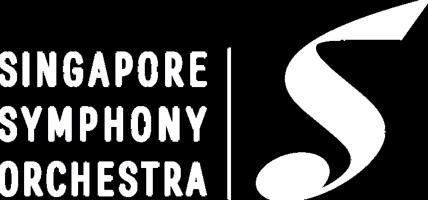

Auditions will be held for shortlisted Singaporean instrumentalists performing concertos written for t heir instrument and Singaporean vocalists performing any vocal work with orchestra.
ELIGIBILITY:
Applicants should be Singapore citizens and should be no more than 25 years of age, as of 1 July 2025.
APPLICATION DEADLINE:
Applicants are invited to submit their online appli cation by , with the following items:
13 December 2024
1. including their date of birth, musical background and contact information
2. A high-quality featuring a recent performance of a complete concerto with either piano or orchestra accompaniment, with composer name, duration of each movement and edition (if applicable) of the work cl early labelled.
For application enquiries, please contact: pypc@sso .org.sg
SCAN TO APPLY
DEADLINE 13 December 2024



Fri, 13 Sep 2024
Victoria Concert Hall
Fri & Sat, 11 & 12 Oct 2024
Victoria Concert Hall 30
Fri & Sat, 25 & 26 Oct 2024
Victoria Concert Hall
For the enjoyment of all patrons during the concert:
• Please switch off or silence all electronic devices.
• Please minimise noises during performance. If unavoidable, wait for a loud section in the music.
• No photography, video or audio recording is allowed when artists are performing.
• Non-flash photography is allowed only during bows and applause when no performance is taking place.
Go green. Digital programme books are available on www.sso.org.sg.
Photographs and videos will be taken at these events, in which you may appear. These may be published on the SSO’s publicity channels and materials. By attending the event, you consent to the use of these photographs and videos for the foregoing purposes.
Cover photo: Sloth Creatives
36
Since its founding in 1979, the Singapore Symphony Orchestra (SSO) has been Singapore’s flagship orchestra, touching lives through classical music and providing the heartbeat of the cultural scene with its 44-week calendar of events.
In addition to its subscription series concerts, the orchestra is well-loved for its outdoor and community appearances, and its significant role educating the young people of Singapore through its school programmes. The SSO has also earned an international reputation for its orchestral virtuosity, having garnered sterling reviews for its overseas tours and many successful recordings. In 2021, the SSO clinched third place in the prestigious Orchestra of the Year Award by Gramophone. In 2022, BBC Music Magazine named the SSO as one of the 23 best orchestras in the world.
In July 2022, the SSO appointed renowned Austrian conductor Hans Graf as its Music Director, the third in the orchestra’s history after Lan Shui (1997-2019) and Choo Hoey (1979-1996). Prior to this, Hans Graf served as Chief Conductor from 2020.
The orchestra performs over 60 concerts a year, and its versatile repertoire spans all-time favourites and orchestral masterpieces to exciting cutting-edge premieres. Bridging the musical traditions of East and West, Singaporean and Asian musicians and composers are regularly showcased in the concert season. The SSO makes its performing home at the 1,800-seat state-of-the-art Esplanade Concert Hall. More intimate works, as well as outreach and community performances take place at the 673-seat Victoria Concert Hall, the Home of the SSO.
Beyond Singapore, the SSO has performed in Europe, Asia and the United States. In May 2016, the SSO was invited to perform at the Dresden Music Festival and the Prague Spring International Music Festival. This successful five-city tour of Germany and Prague also included the SSO’s second performance at the Berlin Philharmonie. In 2014, the SSO’s debut at the 120th BBC Proms in London received praise in major UK newspapers The Guardian and The Telegraph. The SSO has also performed in China on multiple occasions. In the 2024/25 season, the SSO will perform in Kyoto as part of the Asia Orchestra Week, as well as a three-city tour of Australia.
The SSO has released more than 50 recordings, with over 30 on the BIS label. Recent critically acclaimed albums include Herrmann’s Wuthering Heights (Chandos) and Scriabin – Poems of Ecstasy and Fire (BIS). With Singaporean violinist Chloe Chua, the SSO has recorded the Four Seasons, as well as the Butterfly Lovers Violin Concerto, and a Mozart Violin Concerto cycle with Hans Graf to be released by Pentatone Records in the 2024/25 season. The SSO also leads the revival and recording of significant works such as Kozłowski’s Requiem, Ogerman’s Symbiosis (after Bill Evans) and violin concertos by Robert Russell Bennett and Vernon Duke.

The SSO has collaborated with such great artists as Vladimir Ashkenazy, Gustavo Dudamel, Charles Dutoit, Joe Hisaishi, Neeme Järvi, Hannu Lintu, Lorin Maazel, Martha Argerich, Diana Damrau, Janine Jansen, Leonidas Kavakos, Lang Lang, Yo-Yo Ma, Mischa Maisky, Gil Shaham and Krystian Zimerman.
The SSO is part of the Singapore Symphony Group, which also manages the Singapore Symphony Choruses, the Singapore National Youth Orchestra, the Singapore International Piano Festival and the biennial National Piano & Violin Competition.
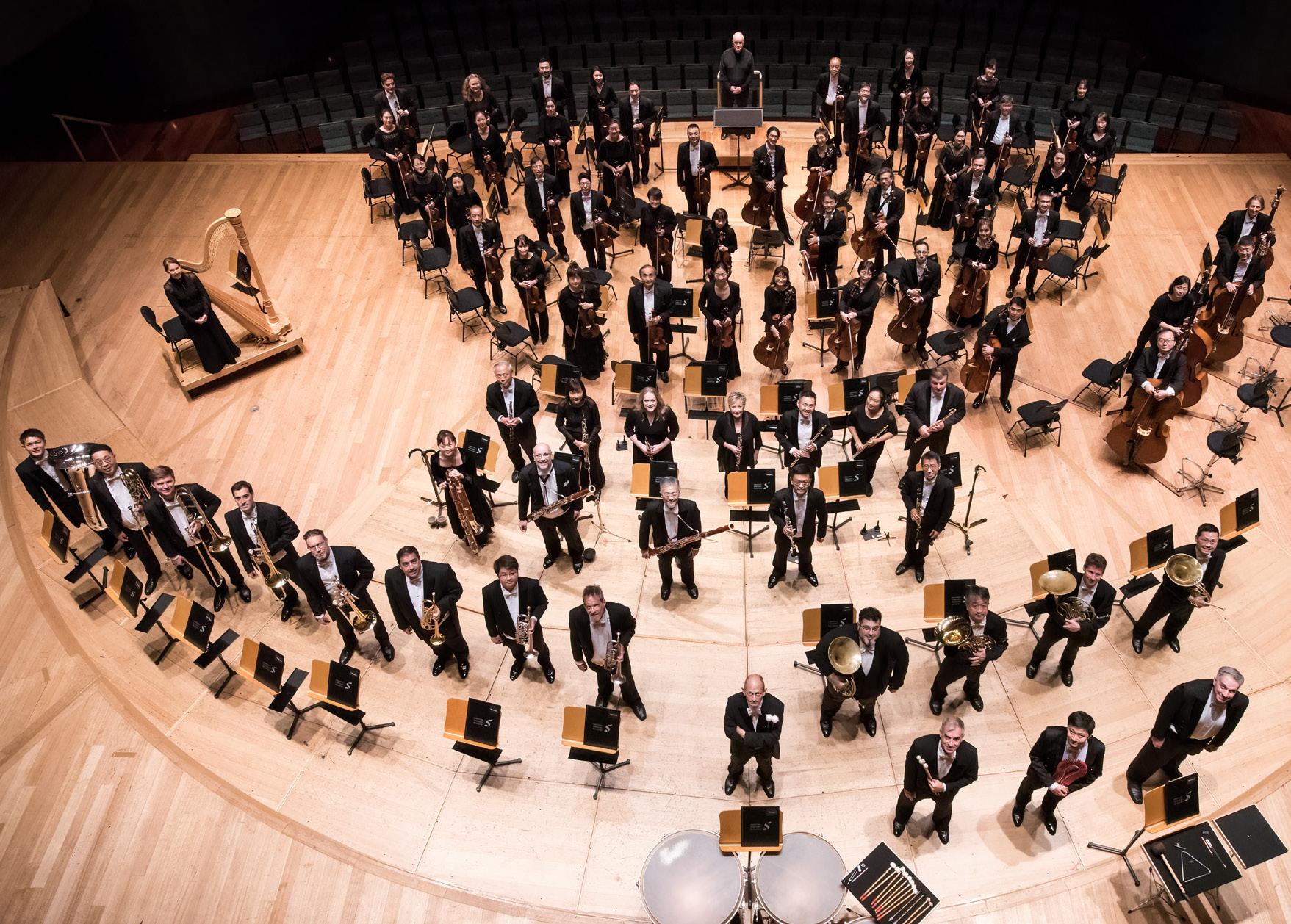
The Group’s vision is to be a leading arts organisation that engages, inspires and reflects Singapore through musical excellence. Our mission is to create memorable shared experiences with music. Through the SSO and its affiliated performing groups, we spread the love for music, nurture talent and enrich our diverse communities.



RODOLFO BARRÁEZ Associate Conductor
A natural communicator with infectious charisma, Berlin-based Venezuelan conductor Rodolfo Barráez brings remarkable vivacity, sensitivity, and zeal to his artistry. The 2023/24 season sees him join the Los Angeles Philharmonic Orchestra as Assistant Conductor, his appointment of Associate Conductor of the Simón Bolívar Symphony Orchestra of Venezuela, as well as begin his second season as Associate Conductor of the Singapore Symphony Orchestra. Rodolfo is also Conductor-in-Residence at the Paris Opera.
In 2023, Rodolfo was awarded first prize at the Hong Kong International Conducting Competition. He also won first prize at the 2018 Universidad Nacional Autónoma de México International Conducting Competition (OFUNAM), and second prize at the 2020 Siemens-Hallé International Conductor Competition in Manchester.
He completed his Bachelor’s and Master’s conducting studies at Hochschule für Musik Hanns Eisler in Berlin, and previously his Bachelor’s at the National Experimental University of the Arts in Venezuela. In 2022, he was selected as Conducting Fellow at the Verbier Festival.
Rodolfo made his debut with Los Angeles Philharmonic in early 2023 at the Walt Disney Concert Hall. He joined the Münchener Kammerorchester on their tour of South
© PEDRO SIERRA
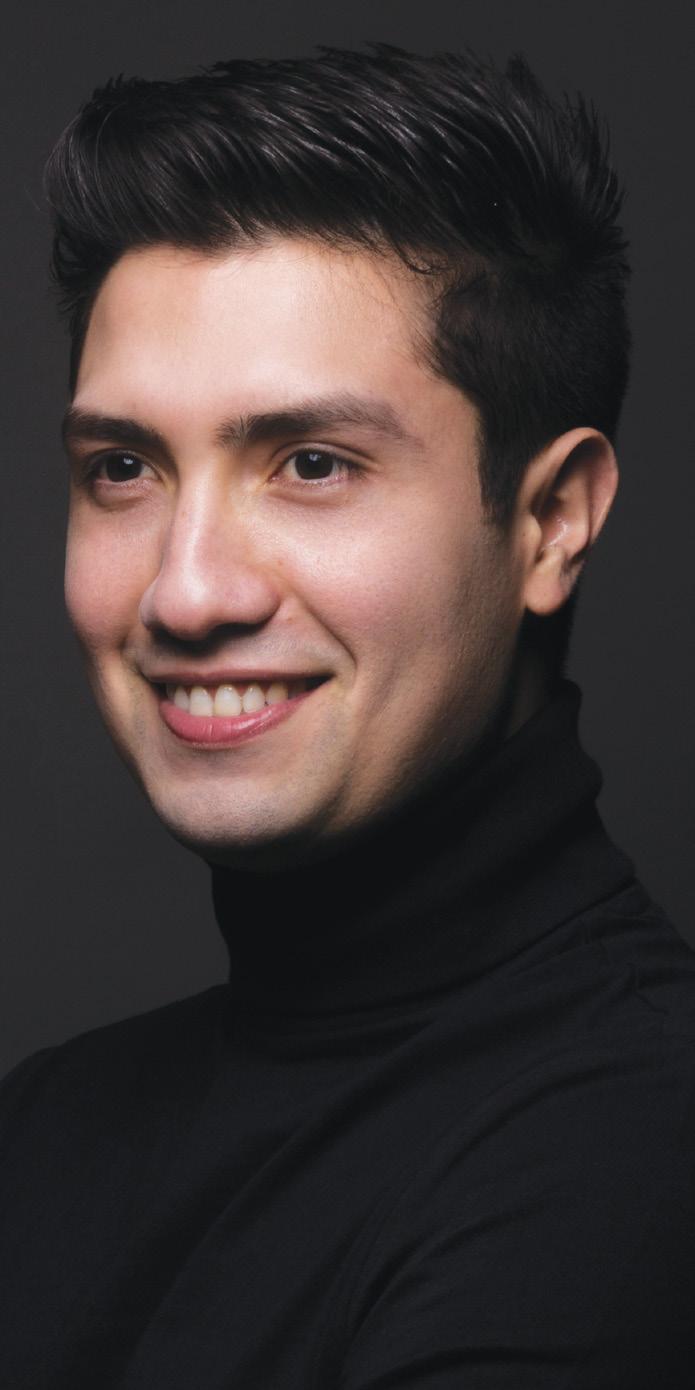
America as well as the Appassionato Orchestra at the Verbier Festival 2022. Future highlights include performances with the Hong Kong Sinfonietta, RTVE Symphony Orchestra, Gävle Symphony Orchestra, Simón Bolívar Symphony, among others.
Strongly influenced by his own remarkable education as part of El Sistema under the guidance of José Antonio Abreu and Teresa Hernández, Rodolfo is committed to contributing to music education. In 2019, Rodolfo founded the Falcón Conducting Workshop; an organization that nurtures and supports the development of emerging conductors through masterclasses and workshops in his hometown as well as worldwide at renowned institutions.

Born in 2008, Singaporean pianist Toby Tan started playing the piano at seven, coinciding with his first public performance at Capitol Theatre for the movie 7 Letters. He has since been actively performing, earning recognition in venues like Esplanade and Victoria Concert Halls, Carnegie Hall’s Weill Recital Hall, and in Germany, Denmark, Italy, Poland, Greece, China, South Korea, Thailand and Malaysia.
Toby has performed with orchestras, his concerto debut at ten with the Soliall Philharmonic (South Korea) and later the Kids’ Philharmonic, Salzburg Chamber Soloists,
Virtuosi Brunenses, Maestoso Chamber Orchestras, T’ang Quartet and Ding Yi Music Company. Performances included concertos by Haydn, Mozart (Nos. 13, 20 and 23), Beethoven (Nos. 2, 3 and Triple Concerto), Grieg, Saint-Saens (No. 2) and in September 2024, Rachmaninoff’s Rhapsody on a Theme of Paganini with the Singapore Symphony Orchestra.
In June, he performed Beethoven’s Piano Concerto No. 3 with the Kids’ Philharmonic at the Berlin Philharmonie. He has also performed with jazz legend Jeremy Monteiro, violinist Chloe Chua and cellist Liu Jiaqi.
In 2023, Toby was awarded 1st prize and Carl Nielsen prize at the Aarhus International Piano Competition (Denmark) and 2nd prize in the Zhuhai International Mozart Competition for Young Musicians (China).
Toby is a Young Artist Programme student at the Yong Siew Toh Conservatory of Music under the tutelage of Albert Tiu, and also studying privately with Armen Babakhanian in Kuala Lumpur. Teachers in his formative years include Rena Phua and Rosemery Halim.
Away from the keyboard, Toby enjoys playing online chess, collecting hats and reading German.
Adrian is a 19-year-old pianist, recently graduated from Anglo-Chinese School (Independent) and currently serving his National Service. While studying for his IB Diploma, Adrian was concurrently a Young Artist at the Yong Siew Toh Conservatory of Music (NUS), under the tutelage of Professor Albert Tiu. He has won first prize in numerous competitions, such as the National Piano & Violin Competition (2023), Young Talents Project (2019), Steinway Youth Piano Competition (2018), PIARA Hamamatsu International Piano Competition (2018) and the Singapore International Festival of Music (2017).
Adrian’s passion for music was at the forefront of his pursuits, especially as an MOE Music Elective Scholar. He served as Principal Double Bassist and Vice-president of his school's Philharmonic Orchestra, and is an alumnus of the Singapore National Youth Orchestra. He also remains an active member of the Orchestra of the Music Makers.
Outside of classical performances, Adrian plays the electric guitar and bass with his band High Places, established through charity performances. He also serves his church as
© NATHANIEL LIM

a keyboardist and singer. In fact, Adrian’s interests are not confined to music alone, having competed with his school’s sailing team and co-founded a school-wide bouldering club.
Adrian hopes to dedicate his gifts to those in need, as he has through working with volunteer organisations like The Purple Symphony and Project Resonance. His ultimate goal is to share the transformative power of music with everyone, regardless of circumstance, and to bring joy in the same way music has done for him.
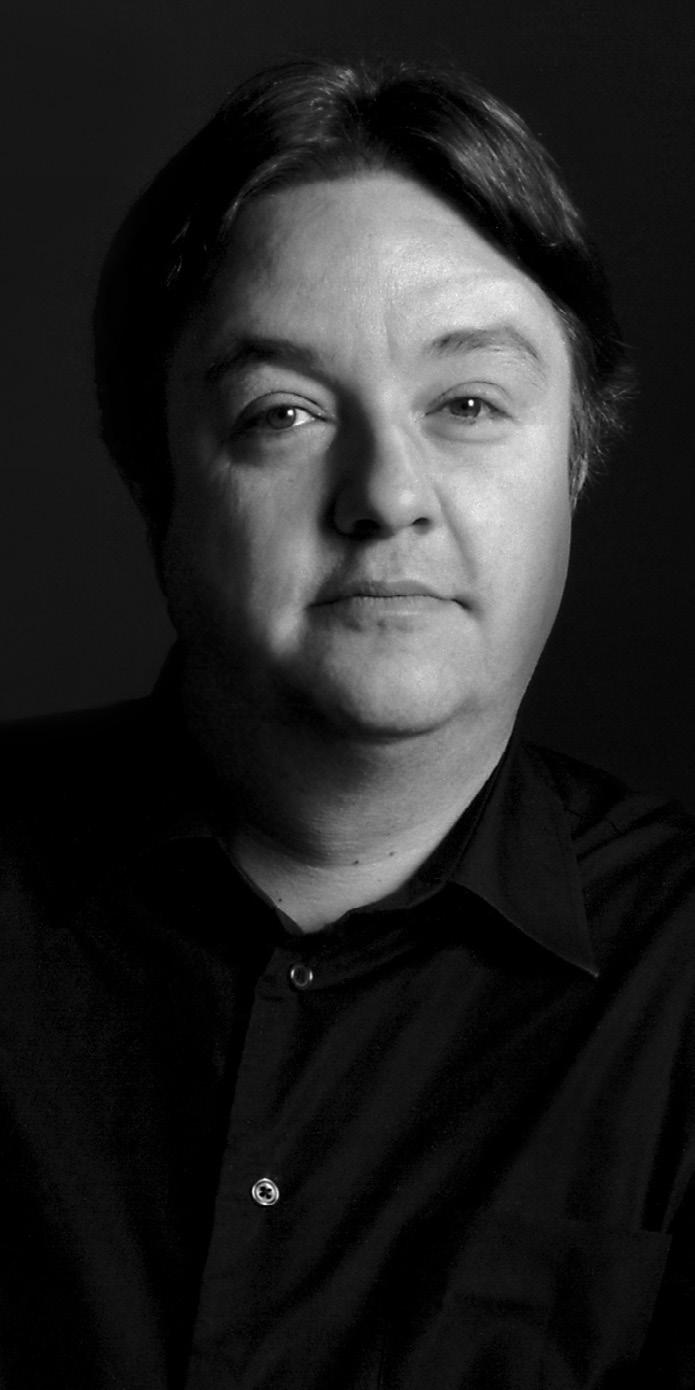
© SCHAFGANS
Stefan Blunier has been Principal Conductor of the Orquestra Sinfónica do Porto Casa da Música since the beginning of 2021. The success story with this orchestra continued in 2023/24 with fruitful collaborations with Stefan Blunier in numerous concerts in Porto.
Recent guest engagements have taken Stefan Blunier to the Orchestre National de Lille, the Copenhagen Philharmonic Orchestra, the Orchestre Suisse Romande, the Bern Symphony Orchestra, the Staatsorchester Darmstadt, the Orchestre symphonique de l'Opéra de Toulon and the Singapore Symphony Orchestra.
Stefan Blunier’s guest-conducting engagements have taken him to nearly all the German radio orchestras as well as the Leipzig Gewandhausorchester, Duisburg Symphony Orchestra, Frankfurt Museumskonzerte, and numerous orchestras in Denmark, Belgium, the Far East, Switzerland and France. Recent highlights include the NHK Symphony Orchestra, BBC Scottish Symphony, National Symphony Orchestra of Ireland, Stuttgart Philharmonic, Staatsphilharmonie RheinlandPfalz, South Netherlands Philharmonic, Norwegian Radio, and the Century Symphony Orchestra of Osaka. Alongside his appointment in Bonn, he was Principal Guest Conductor of the Orchestre National de Belgique (2010–2013).
Stefan Blunier was born in Bern, Switzerland and studied piano, horn, composition and conducting in Bern and at the Folkwang Hochschule in Essen. He is also a founder of the Ensemble für Neue Musik Essen. The early part of career began with successes in the Besançon and Malko Conducting Competitions, which were followed by appointments in Mannheim (Associate Chief Conductor) and Darmstadt (Music Director and Chief Conductor 2001–2008). From 2008–2016 he served as General Music Director of the Opera Bonn and Beethovenorchester Bonn.
Moritz Ernst was born in 1986 in Ostwestfalen, Germany and began playing the piano at the age of five. At age 16, he continued his piano studies in 2002 at the Detmolder Musikhochschule where he also studied musicology. Later on, he continued his studies in London and Basel.
Moritz Ernst is presently concertising as pianist, harpsichordist and chamber musician, performing a wide range of repertoire from baroque to contemporary music. He has appeared in concerts worldwide, and in music festivals such as the Piano Festival Feuchtwangen, the Lake Constance Festival, the Beethoven Festival Bonn; in England, France, Italy, Austria, Sweden, Romania, Belgium, Netherlands, Luxembourg, Switzerland and Russia (St. Petersburg Sound Ways Festival). He has also held masterclasses in Malmö, Stuttgart, Bern, Shanghai, Boston and many other places.
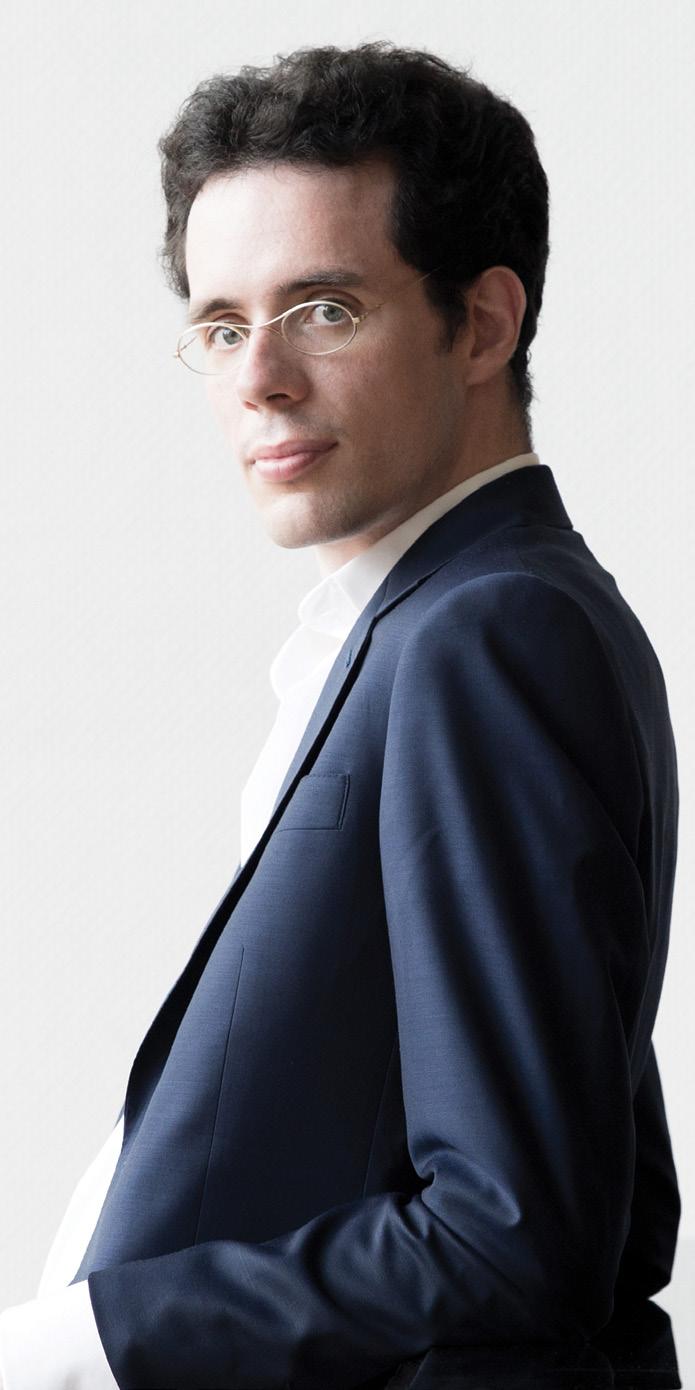
The 2023/24 season saw him perform both in North America and Asia, including live broadcasts from Vienna and TV-recordings for ARTE. His knowledge as musicologist has also led to a cooperation with Schott Verlag. Recently he has published the piano and organ works of Schoenberg’s pupil Norbert von Hannenheim, for Boosey&Hawkes.
Music of the 20th and 21st century is especially dear to his heart. Ernst has premiered several works and collaborated closely with composers such as Eötvös, Pelzel, Bhagwati, Olofsson, Maros and others, some of whom have dedicated works to him. In addition, he advocates the forgotten and less played composers; for example by performing Johann Nepomuk Hummel’s Sonata Op. 106, Feruccio Busoni‘s Fantasia contrappuntistica and the music of Samuel Scheidt, as well as music for the 16th-tone piano.
Moritz Ernst is an official member of Steinway Artists.
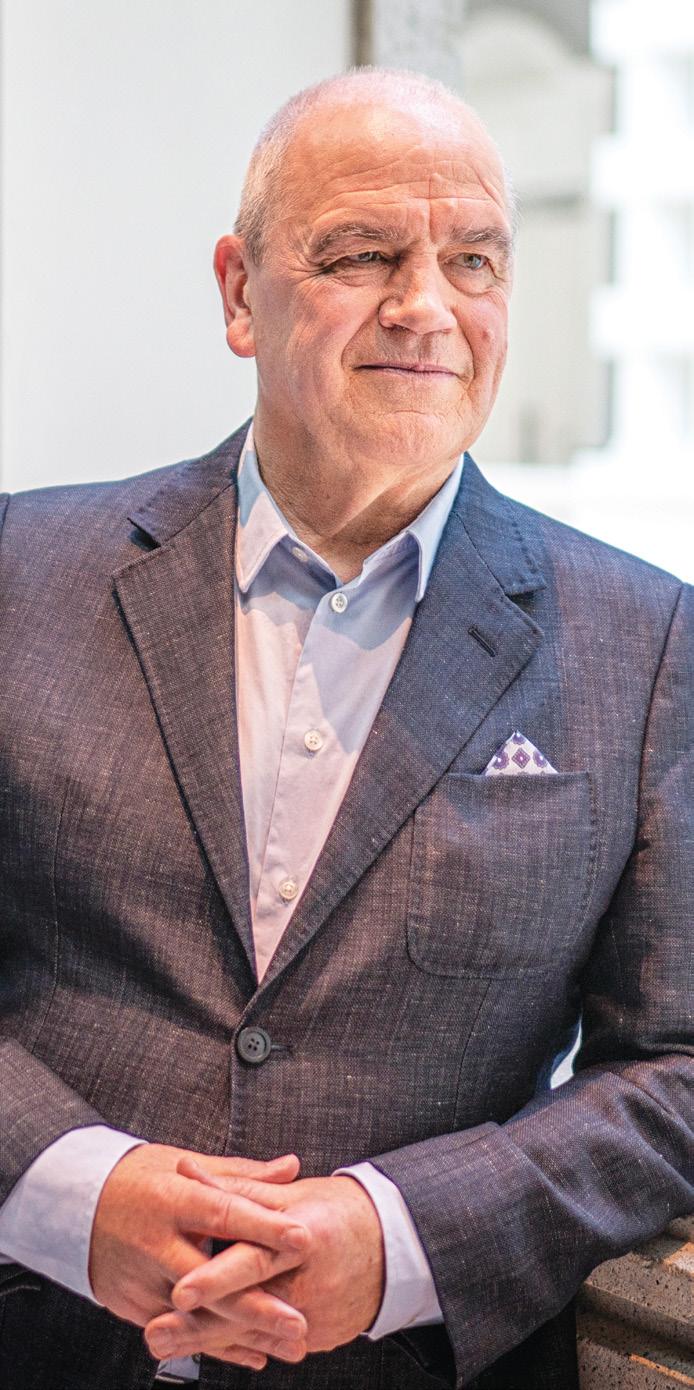
Armed with a spirit of musical curiosity and discovery, creative programming and his commanding presence on stage, Austrian conductor Hans Graf has raised orchestras to new heights while winning audiences young and old alike. With Hans Graf, “a brave new world of music-making under inspired direction” (The Straits Times) began at the Singapore Symphony Orchestra, as Chief Conductor in the 2020/21 season, and Music Director since the 2022/23 season.
Graf was formerly Music Director of the Houston Symphony, Calgary Philharmonic, Orchestre National Bordeaux Aquitaine,
Basque National Orchestra and the Mozarteum Orchestra Salzburg. He is a frequent guest with major orchestras worldwide including the orchestras of Boston, Cleveland, Los Angeles, New York, Philadelphia, Vienna, Leipzig Gewandhaus, DSO Berlin, Dresden, Royal Concertgebouw, Oslo, Hallé, London, Royal Philharmonic, Budapest Festival, St Petersburg, Russian National, Melbourne, Sydney, Seoul, Hong Kong, Malaysia, and the Bavarian, Danish and Netherlands Radio Symphony Orchestras. Graf has led operas in the Vienna State Opera, Munich, Berlin, Paris, Strasbourg, Rome and Zurich. In 2014 he was awarded the Österreichischer Musiktheaterpreis for Strauss’s Die Feuersnot at the famed Vienna Volksoper, where he returned in 2021 to lead Rosenkavalier
Hans Graf’s extensive discography includes all symphonies of Mozart and Schubert, the complete orchestral works of Dutilleux, and the world-premiere recording of Zemlinsky’s Es war einmal. Graf’s recording of Berg’s Wozzeck with the Houston Symphony won the GRAMMY and ECHO Klassik awards for best opera recording. With the Singapore Symphony, Graf has recorded the music of Paul von Klenau, Józef Koz owski’s Requiem, an upcoming Mozart Violin Concerto cycle with Chloe Chua, and Stravinsky Concertos with violinist He Ziyu and pianist Alexei Volodin.
Hans Graf is Professor Emeritus for Orchestral Conducting at the Universität Mozarteum, Salzburg. For his services to music, he was awarded the Chevalier de l'Ordre de la Légion d'Honneur by the French government, and the Grand Decoration of Honour of the Republic of Austria.
EUDENICE PALARUAN
Choral Director
Eudenice Palaruan studied at the University of the Philippines College of Music, majoring in composition and choral conducting. He took further training in choral conducting at the Berliner Kirchenmusikschule, Germany. He graduated doctor of musical arts at St. Paul University Manila.
He was a singer, resident composer/ arranger, and assistant choirmaster of the Philippine Madrigal Singers. In addition, he performed with the Berlin Spandauer Kantorei, the World Youth Choir, and sang countertenor with the Berlin Monteverdichor. In addition, he was the principal conductor of the San Miguel Master Chorale. For years, he has been the resident conductor of the International Bamboo Organ Festival, where he performed and recorded significant selections of Latin-American baroque music. With his active involvement in the choralization of Philippine and other Asian indigenous music, he premiered a substantial volume of new Asian choral works. In addition, he was often invited to give lectures on non-Western vocal aesthetics.
Eudenice also arranges for the SSO choruses and the SSC community outreach programmes. In addition, the SSO choruses have premiered new choral works written by local composers and arrangers in Singapore under his direction.
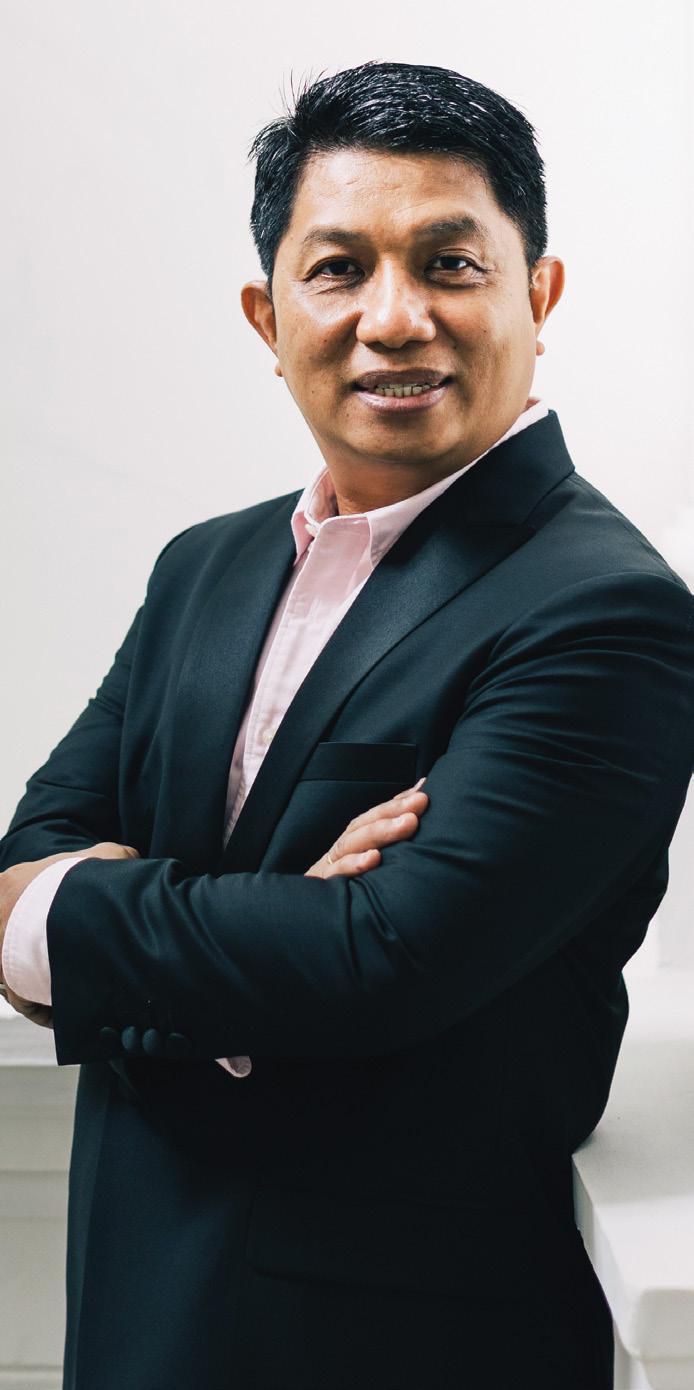
He taught composition and choral conducting in institutions such as the University of the Philippines College of Music, the Asian Institute for Liturgy and Music, and St. Paul University College of Music and the Performing Arts. In addition, he teaches at the Singapore Bible College School of Church Music and directs the SBC Chorale. Eudenice is often invited to adjudicate in international composition competitions and give masterclasses in choral conducting.
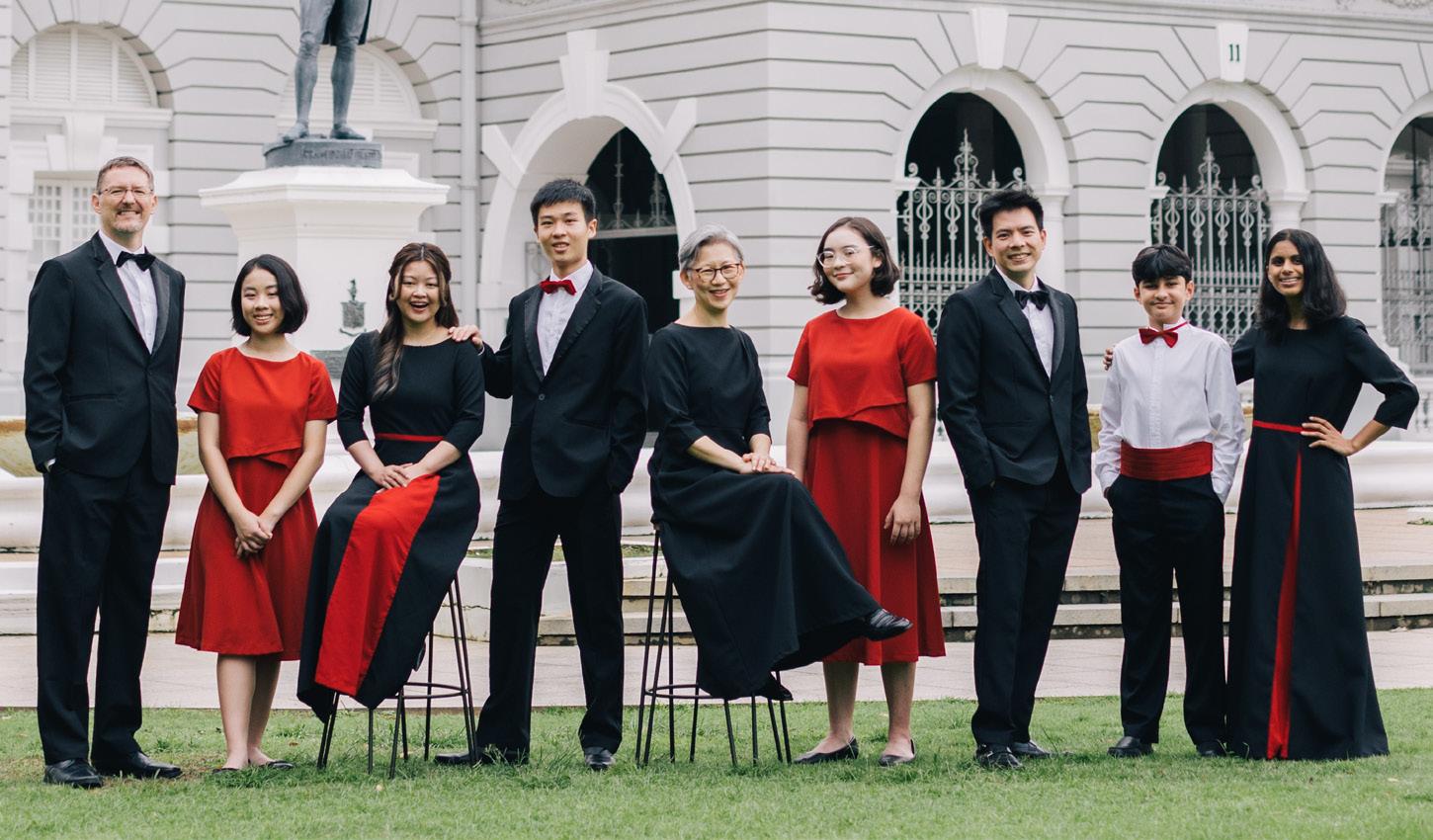
A premier body for classical choral singing, the Singapore Symphony Choruses comprise the Singapore Symphony Chorus (SSC), Singapore Symphony Youth Choir (SSYC) and Singapore Symphony Children’s Choir (SSCC).
Drawing membership from diverse ages, nationalities and walks of life, our Choruses embody a comprehensive singing ecosystem that nurtures the brilliance of our brightest young talents, inspires youthful passion for the art and celebrates the best of choral excellence!
At the heart of our holistic training approach, our Choruses are committed to fostering artistic growth and well-rounded personal development, in delivering outstanding performances. Singers are provided with the richest and most unique performing experiences and opportunities to record and perform with some of the world’s most distinguished conductors, artistes and renowned orchestras.
Straddling musical worlds and styles, the Choruses’ repertoire ranges from orchestral masterpieces to a cappella favourites, spanning the Renaissance to contemporary 21st-century music.
Treble Voices of the Singapore Symphony Chorus & Youth Choir
Rehearsal Pianist, Low Jinhong
SOPRANO
Josephine Budiana
Goh Chen Xi
Kaitlyn Kim
Giselle Lim
Desiree Seng
Janelle Tan
Gladys Torrado
Jocelyne Harefa
ALTO
Chng Xin Bei
Truly Hutapea
Sarah Tang
Ng Sheh Feng*
Tan Seow Yen
Janice Chee
Rina Ushioda
Suzannah Kewley
*Choral Associate
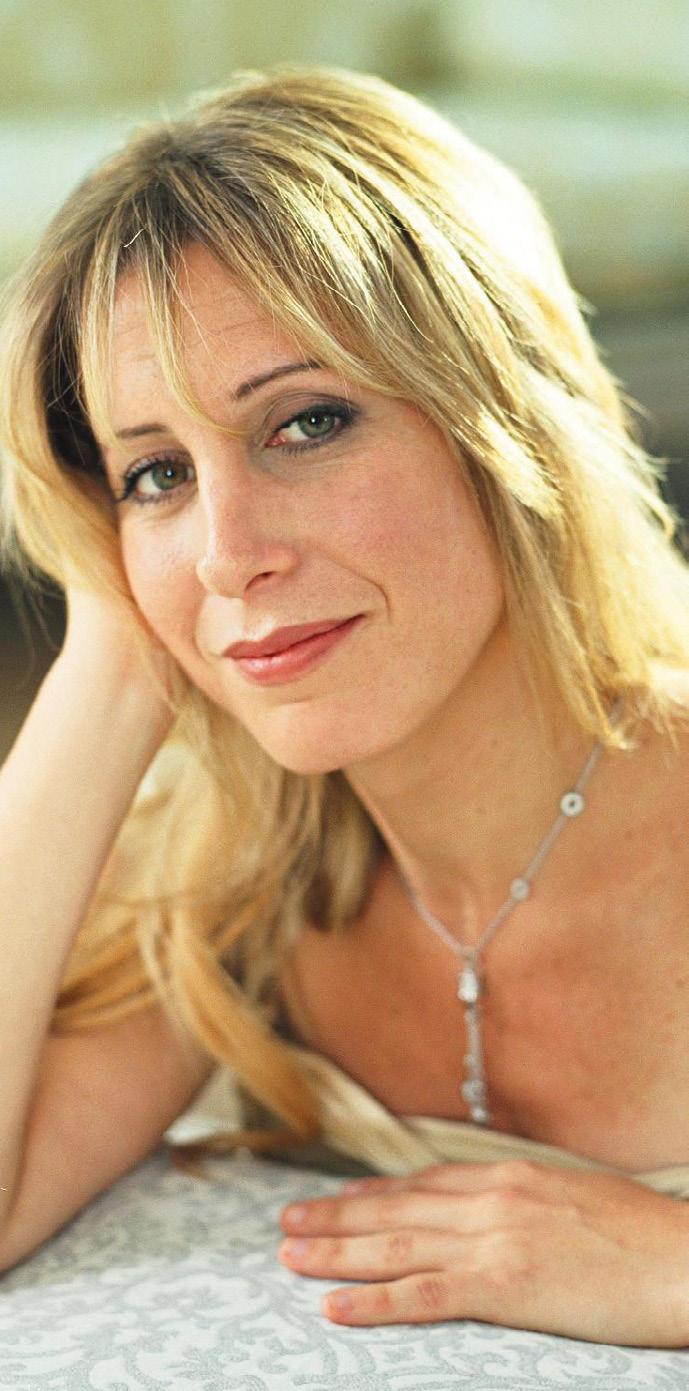
© GARY HOULDER
Argentine pianist Ingrid Fliter has won the admiration and hearts of audiences around the world for her passionate yet thoughtful and sensitive music making played with an effortless technique. Winner of the 2006 Gilmore Artist Award, one of only a handful of pianists and the only woman to have received this honour, Ingrid Fliter divides her time between North America and Europe.
Recent European engagements include appearances with the Royal Stockholm Philharmonic and in recitals in Stockholm and at London’s Wigmore and Queen Elizabeth Halls.
Ingrid Fliter made her American orchestral debut with the Atlanta Symphony just days after the announcement of her Gilmore award. Since then, she has appeared with most of the major North American orchestras and summer festivals. In recitals, she has performed in the major venues of North America including Carnegie, the Metropolitan Museum, and in Chicago, Boston, Vancouver and Van Cliburn, Fort Worth.
Elsewhere Ingrid has performed in the Singapore International Piano Festival; she has also made numerous trips to Japan, Hong Kong, Australia and New Zealand.
Ingrid Fliter records with Linn Records; recent releases include both Chopin concertos with the Scottish Chamber Orchestra/ Jun Märkl, the Mendelssohn and Schumann also with Scottish Chamber, and the complete Chopin Preludes and Nocturnes. Her next release, featuring Chopin Mazurkas, will be released in early 2025.
Born in Buenos Aires in 1973, Ingrid Fliter moved to Europe in 1992. She has been teaching at the Imola International Academy “Incontri col Maestro” since the autumn of 2015.
actress/narrator
Maureen Thomas is a Canadian stage and film actress with extensive experience in both classical and contemporary works. She has appeared in nearly a hundred important theatrical productions – including leading roles in Hamlet, The Cherry Orchard, Cabaret, On Golden Pond, Six Degrees of Separation and Driving Miss Daisy.
And she has treasured memories of being in M. Butterfly, starring Ivan Heng, founding Artistic Director of Singapore’s Wild Rice Theatre.
Maureen’s film work includes roles in the series Supernatural, The BBC miniseries Burn Up, the comedy series Psych, the Netflix thriller Hold the Dark, Christmas TV specials Deck the Halls, Home for the Holidays, and A Dickens of a Christmas.
She has just finished shooting in an episode of the upcoming Netflix series The Abandons. After Singapore she will be playing the lead in a new Canadian play, Liars at a Funeral.
However, one production has been endlessly special – the beautiful amalgamation of Shakespeare’s endearing “Midsummer Night’s Dream” and the gorgeous music Mendelssohn composed for it. The magic of the orchestra, the beauty of the chorus, and scenes from the play brought to life
© ALEX BUISSE
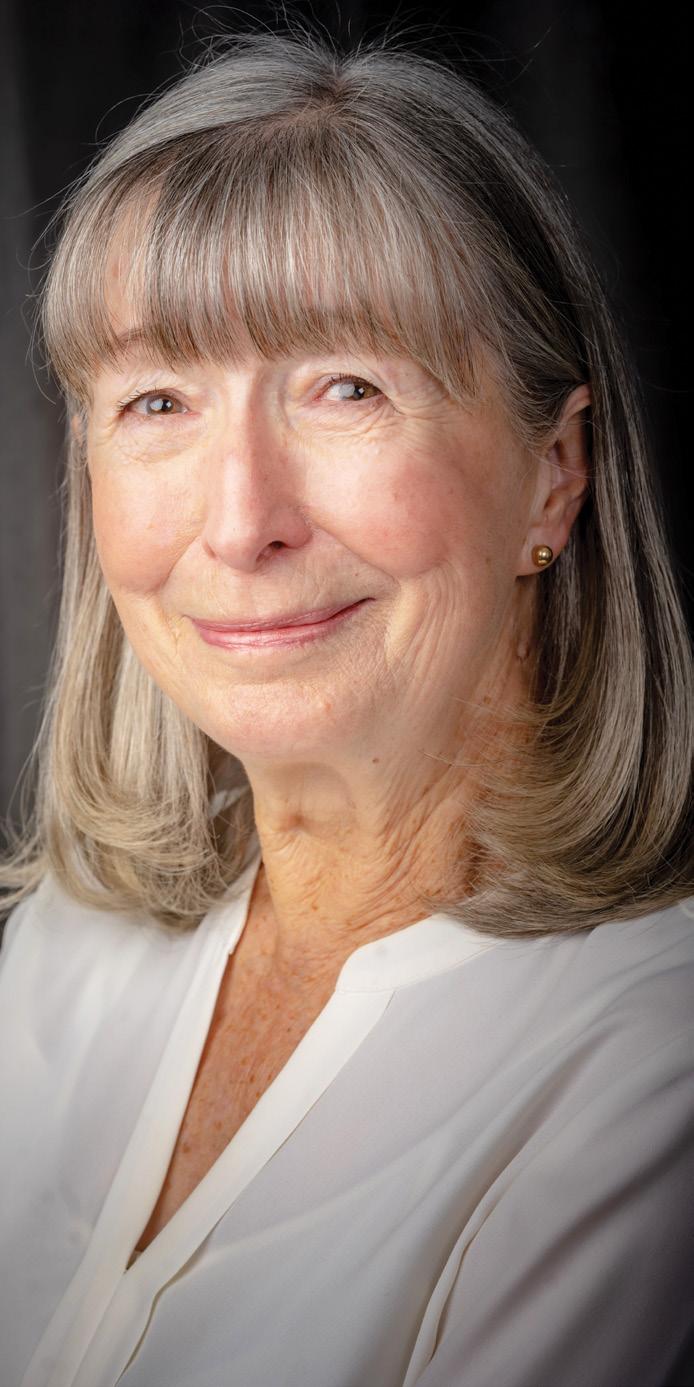
by a single actor. Critics have responded with enthusiasm: “dazzling”, “exhilarating”, “magical”, “superbly interpreted”.
Maureen has created this exclusive version together with Hans Graf and has since performed it many times, with orchestras in Canada, across the United States (including the Houston Symphony, the National Symphony Orchestra and the St Paul Chamber Orchestra), and in Europe.
And she is very happy to be performing it here, for you.
“Seldom has observing the act of someone talking to herself been so enormously entertaining.”
Adrian Tan is a highly acclaimed and soughtafter lighting designer from Singapore. He has a wealth of experience, having designed and created shows that have been staged on the local and international arts scene. It spans a wide spectrum of the performing arts and outdoor light installations.
He also had the opportunity to work on multidisciplinary entertainment projects such as collaborations with Disney and Lucasfilm. A collaboration with the UK’s prominent landscape artist Tom Massey for the Singapore Garden Festival 2018 also led to a win in the Best Indoor Lighting Award during the festival.
Adrian is also the founder of The Light Project, a design studio dedicated to explore the creative potential of light as a main medium for artistic expression and to push the boundaries of lighting design.
Several of his theatre works have received theatre awards, including shows like Monkey Goes West and Another Country by Wild Rice Singapore, A Cage Goes in Search of a Bird by A Group Of People, BITCH for the M1 Fringe Festival and Dark Room, which was commissioned by The Esplanade.
Leong Shan Yi is a stage manager based in Singapore. Since joining the Singapore Symphony Orchestra in the beginning of 2023, she has played a pivotal role in orchestrating numerous high-profile performances, collaborating with renowned conductors and soloists. Significant productions she has engaged in include Ravel’s celebrated opera L’Heure espagnole (The Spanish Hour) and Beethoven’s Ode to Joy.
She also has vast experience in television production, spending eight years as a writer and producer specializing in documentary and reality programmes for both local and international broadcasters. Notable highlights of her media career include managing three seasons of the acclaimed MasterChef Singapore as a casting producer.
Beyond her stage management duties, Shan Yi is an avid equestrian passionate about horses, often embarking on numerous trail riding journeys across continents. In addition to trail and dressage riding, she actively engages in the local equestrian community, volunteering at a social enterprise providing equine-assisted therapy for children with special needs.




A premier body for classical choral singing, the Si ngapore Symphony Choruses comprise the Singapore Symphony Chorus, Si ngapore Symphony Youth Choir and Singapore Symphony Childre n’s Choir.
Drawing membership from diverse ages, nationalities and walks of life, our Choruses embody a comprehensive singing ecosyst em that nurtures the brilliance of our brightest young talents, insp ires youthful passion for the art and celebrates the best of choral excel lence!

Scan the QR code and visit our website for more det ails on audition and training opportunities.
@singaporesymphony
@sgsymphonychorus
@sgsymphonyyouthchoir
@sgsymphonychildrenschoir
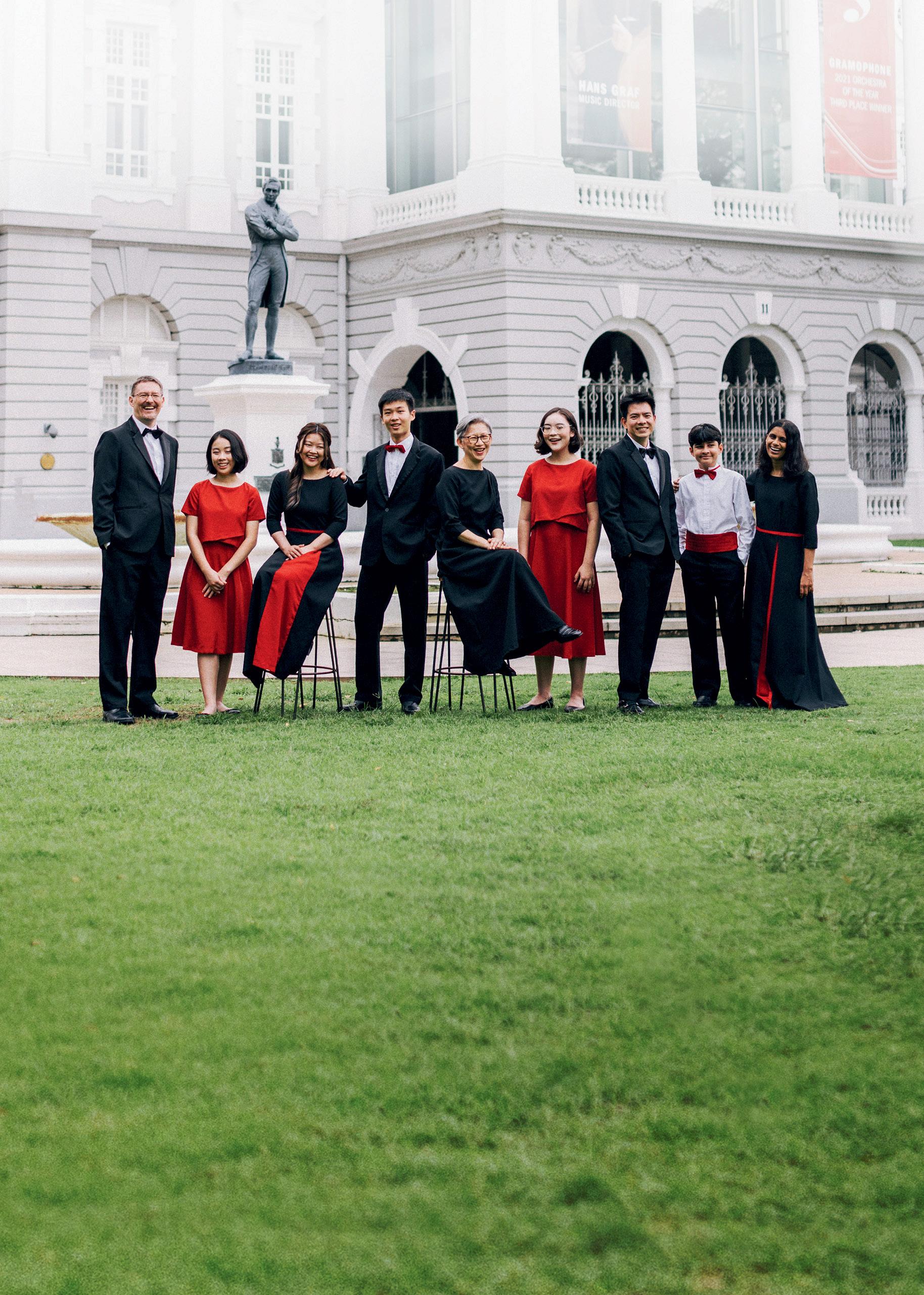

Scan for more information Or visit our website at sso.org.sg/choruses
HANS GRAF
Music Director
RODOLFO BARRÁEZ
Associate Conductor
CHOO HOEY
Conductor Emeritus
LAN SHUI
Conductor Laureate
EUDENICE PALARUAN
Choral Director
WONG LAI FOON
Choirmaster
ELLISSA SAYAMPANATHAN
Assistant Choral Conductor
FIRST VIOLIN
(Position vacant) Concertmaster,
GK Goh Chair
David Coucheron
Co-Principal Guest Concertmaster
Kevin Lin
Co-Principal Guest Concertmaster
Kong Zhao Hui1
Associate Concertmaster
Chan Yoong-Han2
Fixed Chair
Cao Can*
Duan Yu Ling
Foo Say Ming
Jin Li
Kong Xianlong
Cindy Lee
Karen Tan
William Tan
Wei Zhe
Ye Lin*
Zhang Si Jing
SECOND VIOLIN
Nikolai Koval*
Sayuri Kuru
Hai-Won Kwok
Margit Saur
Shao Tao Tao
Tseng Chieh-An
Wu Man Yun*
Xu Jueyi*
Yin Shu Zhan*
Zhao Tian
VIOLA
Manchin Zhang Principal, Tan Jiew Cheng Chair
Guan Qi Associate Principal
Gu Bing Jie* Fixed Chair
Marietta Ku
Luo Biao
Julia Park
Shui Bing
Janice Tsai
Dandan Wang
Yang Shi Li
CELLO
Ng Pei-Sian Principal, The HEAD Foundation Chair
Yu Jing
Associate Principal
Guo Hao Fixed Chair
Chan Wei Shing
Christopher Mui
Jamshid Saydikarimov
Song Woon Teng
Wang Yan
Wu Dai Dai
Zhao Yu Er
DOUBLE BASS
Yang Zheng Yi Associate Principal
Karen Yeo Fixed Chair
Jacek Mirucki
Guennadi Mouzyka
Wang Xu
FLUTE
Jin Ta Principal, Stephen Riady Chair
Evgueni Brokmiller Associate Principal
Roberto Alvarez
Miao Shanshan
PICCOLO
Roberto Alvarez Assistant Principal
OBOE
Rachel Walker Principal
Pan Yun Associate Principal
Carolyn Hollier
Elaine Yeo
COR ANGLAIS
Elaine Yeo Associate Principal
CLARINET
Ma Yue Principal
Li Xin Associate Principal
Liu Yoko
Tang Xiao Ping
BASS CLARINET
Tang Xiao Ping Assistant Principal
BASSOON
Liu Chang Associate Principal
Christoph Wichert
Zhao Ying Xue
CONTRABASSOON
Zhao Ying Xue Assistant Principal
Austin Larson Principal
Gao Jian Associate Principal
Jamie Hersch Associate Principal
Marc-Antoine Robillard Associate Principal
Bryan Chong^
Hoang Van Hoc
TRUMPET
Jon Paul Dante Principal
David Smith Associate Principal
Lau Wen Rong
Nuttakamon Supattranont
TROMBONE
Allen Meek Principal
Damian Patti Associate Principal
Samuel Armstrong
BASS TROMBONE
Wang Wei Assistant Principal
TUBA
Tomoki Natsume Principal
TIMPANI
Christian Schiøler Principal
Mario Choo
PERCUSSION
Jonathan Fox Principal
Mark Suter Associate Principal
Mario Choo
Lim Meng Keh
HARP
Gulnara Mashurova Principal
With deep appreciation to the Rin Collection for their generous loan of string instruments. Musician on temporary contract
Kong Zhao Hui performs on a J.B. Guadagnini of Milan, c. 1750, donated by the National Arts Council, Singapore, with the support of Far East Organization and Lee Foundation.
Chan Yoong-Han performs on a David Tecchler, Fecit Roma An. D. 1700, courtesy of Mr G K Goh.
Musicians listed alphabetically by family name rotate their seats on a per programme basis.
PRESIDENT’S YOUNG PERFORMERS CONCERT | 13 SEP 2024
FLUTE
Wang Tong
PERCUSSION
Michael Tan Pei Jie
FIRE, FANTASIA AND PULCINELLA | 11 & 12 OCT 2024
FIRST VIOLIN
Markus Gundermann Guest Concertmaster
SECOND VIOLIN
Lisa Obert Guest Principal
BASSOON
Ignas Mazvila Guest Principal
HARPSICHORD
Shane Thio
A MIDSUMMER NIGHT’S DREAM | 25 & 26 OCT 2024
FIRST VIOLIN
Markus Gundermann Guest Concertmaster
SECOND VIOLIN
Lisa Obert Guest Principal
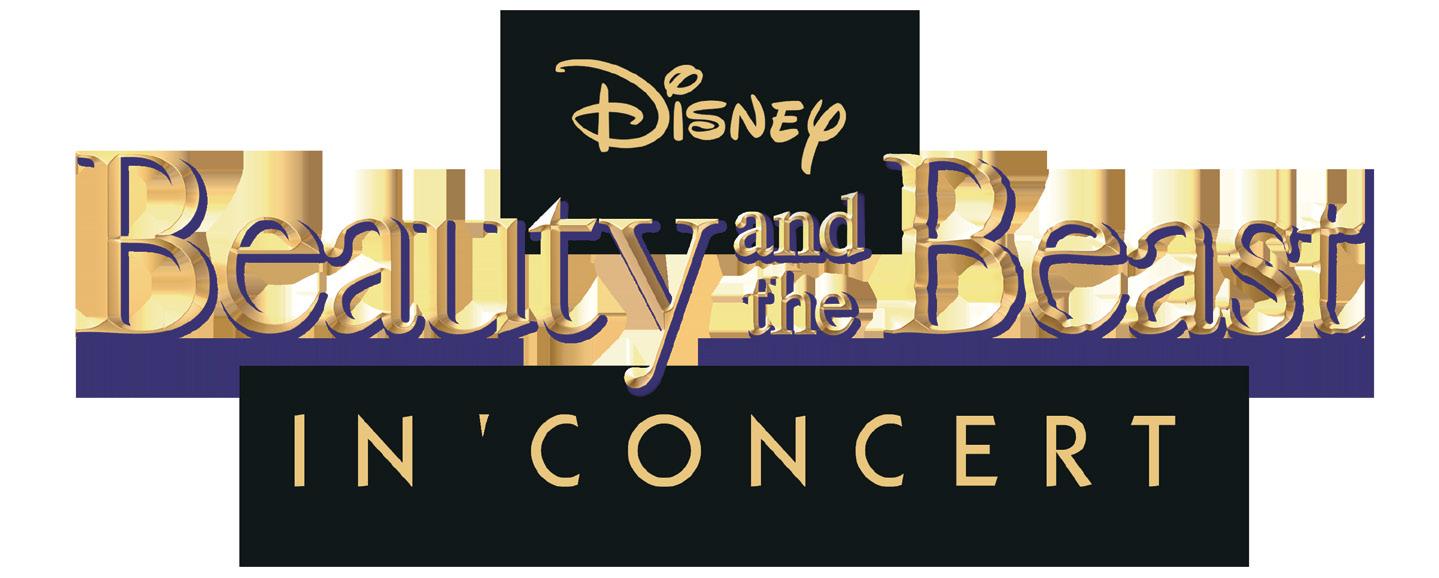
PRESENTED BY ORCHESTRA PAPTNER TICKETING PAPTNER



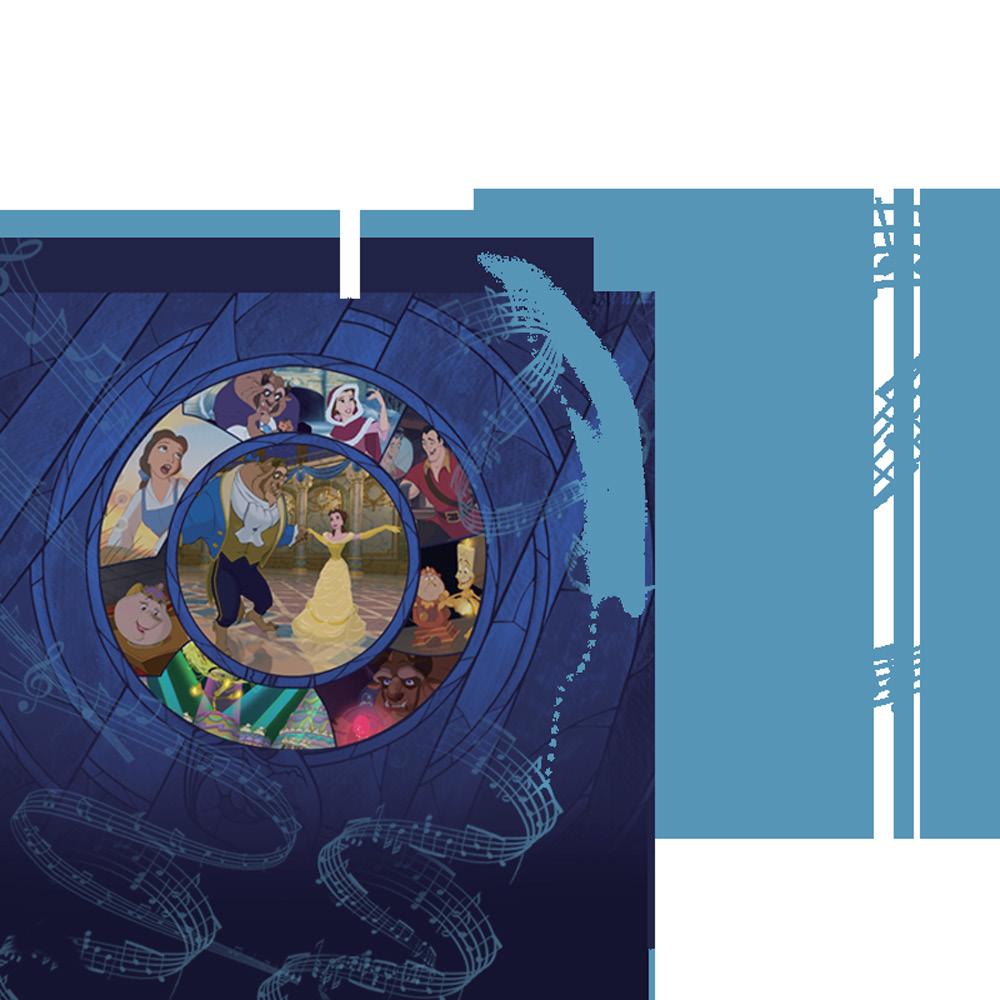


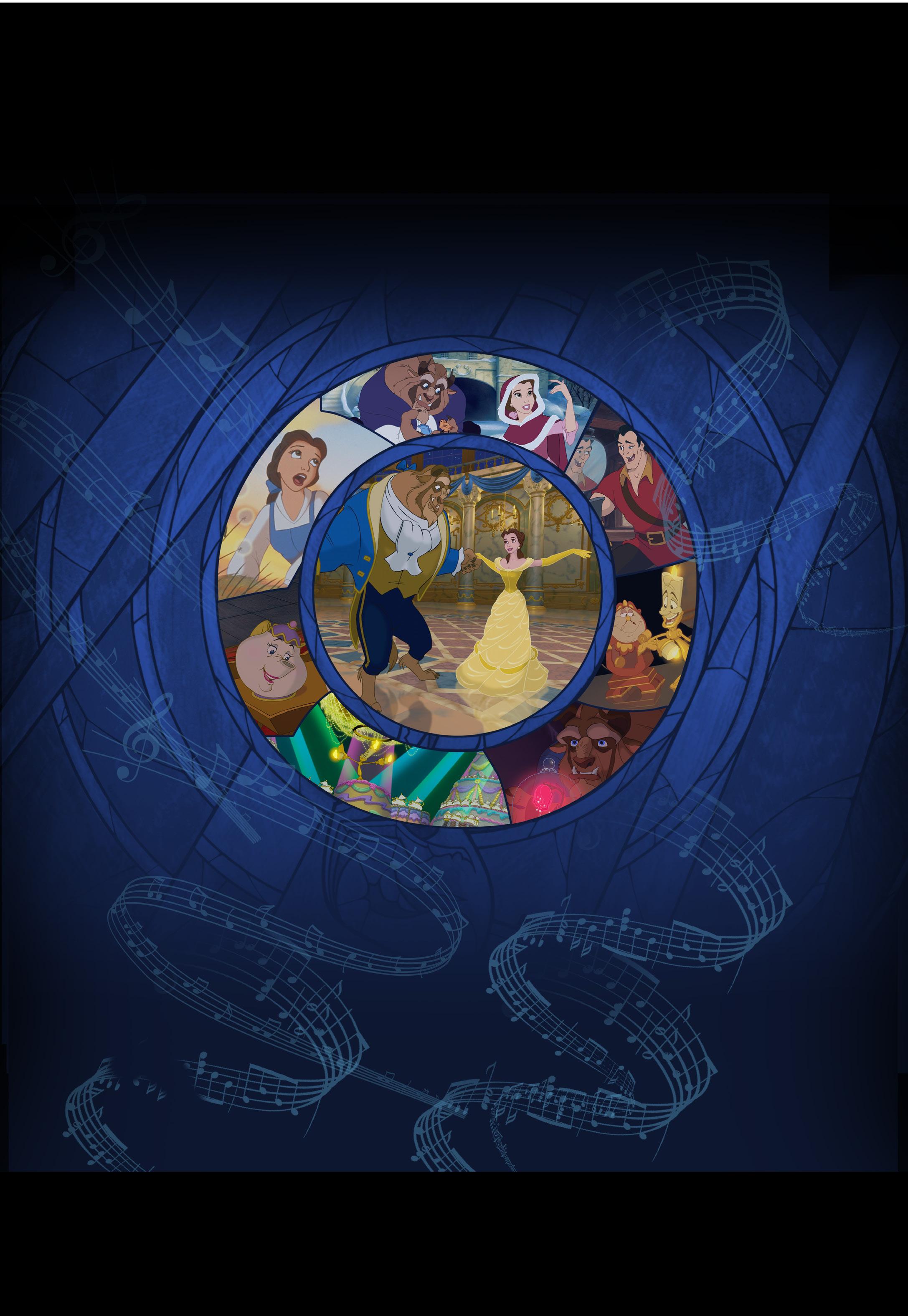

Fri, 13 Sep 2024
Singapore Symphony Orchestra
Rodolfo Barráez Associate conductor
Toby Tan piano1
Adrian Tang piano2
Overture to A Midsummer Night’s Dream
Rhapsody on a Theme of Paganini, Op. 431
Intermission
Piano Concerto No. 1 in D-flat major, Op. 102
Symphony No. 1 in D major, Op. 25 “Classical”
Felix Mendelssohn’s career as a pianist, composer, and conductor was enriched by a cultured upbringing. His parents’ Berlin home played host to a vibrant intellectual salon, its guests including scientists, philosophers, writers, actors, and musicians. The Mendelssohn siblings were avid readers and often acted out Shakespeare’s plays. At the age of 17, Mendelssohn wrote his Overture to A Midsummer Night’s Dream, a comedy centred around the marriage of Duke Theseus of Athens and the Amazon queen, Hippolyta. Mendelssohn first played it in a two-pianos version with his sister Fanny, before orchestrating it for public performance. While opera overtures had become popular in the early 19th century, this is regarded as the first concert overture, a genre intended as a standalone piece without reference to theatrical performance, and typically inspired by literary themes.
The Overture opens with four woodwind chords inviting us into a moonlit world. Staccato strings depict the fairies scurrying through the woods and a trumpet fanfare heralds the royal court and hunting scenes, before the full orchestra declares the noble lovers’ theme in all its sweet yearning. Fortissimo accents in the lower strings and brass crank out a rustic rhythm for the ‘rude mechanicals’, a group of labourers with misguided acting aspirations staging a play for the Duke’s wedding. Downward sliding strings evoke the hee-haw braying of Bottom, who has been transformed into a donkey by Puck’s mischievous magic. A development section ensues, where the fairy motif descends into greater mystery. Each
key character returns in the recapitulation, and the Overture closes with the same four chords of the opening.
Notes by See Ning Hui
Instrumentation
2 flutes, 2 oboes, 2 clarinets, 2 bassoons, 2 horns, 2 trumpets, tuba, timpani, strings
World Premiere 20 Feb 1827, Stettin (now known as Szczecin, city in Poland)
First performed by SSO 5 Sep 1986
Rhapsody on a Theme of Paganini, Op. 43 (1934)
Many and varied are the compositions based on the last of Paganini’s 24 Caprices for Violin Solo. Schumann, Liszt, Brahms, Lutos awski, Schnittke and even Andrew Lloyd Webber, among many others, have fallen under the spell of the irresistible tune. But best known of all is surely Rachmaninoff’s interpretation, his last work for piano and orchestra, written in 1934 when the composer was 61 and living in Lucerne, Switzerland. Wit, charm, romance, rhythmic verve and masterly orchestration combine in what many listeners consider to be one of his finest works. The world premiere was given on 7 November 1934 in Baltimore by the Philadelphia Orchestra with the composer as soloist.
The Rhapsody on a Theme of Paganini is not, as the title implies, really a rhapsody at all. However, one might associate the piano soloist with the role of the ancient Greek rhapsode, the specially trained singer or reciter of epic poems. Additional meanings have been associated over the years with the word “rhapsody.” We might now define rhapsody as a high-charged instrumental work in irregular, free or improvisatory form. Though generally in a single movement, the rhapsody usually consists of several linked sections.
Rachmaninoff’s Rhapsody on a Theme of Paganini conforms to this definition in most respects, but it is definitely not free or improvisatory in form. It follows a very clear-cut design, namely, a set of 24 variations. The work begins with the curiously “misplaced” first variation (following an eight-bar introduction); only
then do we hear the theme in its original, intact form, played by violins with piano accentuations. Variations 2-5 all retain rhythmic tautness and drive. Only in Variation 6 does a more rhythmically free and sentimental tone creep in.
A new theme enters at Variation 7, that old funeral chant, the Dies irae, which Rachmaninoff had incorporated into so many of his works. In fact though, there is a melodic kinship between the chant theme and Paganini’s. The Dies irae returns in Variation 10, a grotesque march. In between Variations 8 and 9, a demonic quality is introduced, especially in Variation 9, with its col legno (string players using the wooden part of their bows), tappings and frenzied rhythmic conflict between orchestra and soloist.
Variation 11 is essentially a highly florid cadenza with a true rhapsodic flavour to it. Two variations in D minor follow: one a nostalgic, wistful minuet set to Paganini’s fragmented theme; the other a sturdy pronouncement of the theme, still in triple meter, in a more straightforward presentation. Variations 14 and 15 are in F major, with the latter almost entirely for piano alone.
Dark, ominous, even ghostly stirrings seem to emanate from Variation 16, in the key of B-flat minor. The scoring is of chamber-music delicacy and transparency, as opposed to the block-like orchestral writing of most previous variations. Variation 17 does nothing to lighten the oppressive mood, as the soloist gropes in strange, remote harmonic regions.
Suddenly, as if emerging into the light of day, we hear the sounds of an old friend softly intoned: that famous Variation 18 in that most romantic of keys, D-flat major. (The famous theme from Tchaikovsky’s Piano Concerto is also in D-flat.) This lush, glorious melody is no intrusion, for like the Dies irae, it too bears a melodic relationship to the Paganini theme; in fact, it is almost an inverted image of it.
The music, from now on in the initial key of A minor, proceeds swiftly to its conclusion, each variation more scintillating than the last. Brief cadenzas conclude Variations 22 and 23; Variation 24 leads directly into the coda. The Dies irae blares out full force in the brass. The gathering momentum and dazzling passage work for the soloist lead one to expect a conclusion of overwhelming bravura and force. Indeed, this expectation is very nearly fulfilled, but at the last moment, Rachmaninoff pulls back and, as if with a wicked chuckle, ends his Rhapsody with a final, lost fragment of the memorable theme.
Notes by Robert Markow
Instrumentation
solo piano, 2 flutes, piccolo, 2 oboes, cor anglais, 2 clarinets, 2 bassoons, 4 horns, 2 trumpets, 3 trombones, tuba, timpani, triangle, cymbals, suspended cymbal, snare drum, bass drum, glockenspiel, harp, strings
World Premiere 7 Nov 1934, Baltimore
First performed by SSO 24 Aug 1982 (Seow Yit Kin, piano)
Piano Concerto No. 1 in D-flat major, Op. 10 (1912)
Allegro brioso
Andante assai
Allegro scherzando
Prokofiev’s shortest and most high-octane concerto was dedicated to his conducting teacher “the dreaded Tcherepnin”, whose harsh criticisms of his student earned his dislike, but who was also credited for the Neo-classicism of his early works. Prokofiev’s penchant for unorthodox harmonies, his interest in rhythm over melody, and an aggressive treatment of the piano put him at loggerheads with his professors at the Saint Petersburg Conservatory.
The only element which could truly be labelled Classical is Prokofiev’s use of form. Despite its one-movement structure, it emulates the typical fast-slow-fast threemovement concerto and is often listed as such. With the strings and piano in unison, the Allegro brioso opens with powerful swagger. This opening theme would return at the Concerto’s midpoint and the conclusion, serving as a structural pillar. It is not developed any further but is, instead, fragmented into its barest form of dotted rhythm repeated notes, then sprinkled across the music. The pianist takes off in a toccata-like episode, with the strings occasionally chiming in. Melodic moments are rare, but Prokofiev demonstrates just how effective scales and chromaticism can be. A darker second subject offers sinister rumblings in the bass. This relaxes into the contrasting Andante assai section—at times beautifully bizarre, and at other times, almost fairytale-like in its whimsy. There are brief moments hinting

Prokofiev at the piano (1918)
at the darkness and despair that would colour Prokofiev’s later works, such as the Piano Concerto No. 2 and his symphonies. Much of the orchestration is also novel; the glockenspiel pairs up with the piano in an exuberant display of joie de vivre. In the Allegro scherzando, a brusque unison of French horns and the tuba announces the cadenza—where the pianist’s solo pyrotechnics feature—then the timpani roll joins in the breathless sprint to the finish.
Unable to appreciate the Concerto’s Modernist qualities, the critics at its 1912 premiere called it “the work of a madman”. The crowd loved it and summoned Prokofiev for three encores. In an audacious gamble, Prokofiev played his own Concerto in the 1914 Rubinstein Competition, rather than the conventional Classical choice. He reasoned that the work “might impress the examiners by the novelty of technique; they simply would not be able to judge whether I was playing it well or not!” The jury awarded him the prize, albeit reluctantly. The Concerto exemplifies Prokofiev’s defiance of the conservatoire tradition and marked the start of a new path, both for himself and for the sound worlds of the 20th century.
Notes by See Ning Hui
Instrumentation
solo piano, 2 flutes, piccolo, 2 oboes, 2 clarinets, 2 bassoons, contrabassoon, 4 horns, 2 trumpets, 2 trombones, bass trombone, tuba, timpani, glockenspiel, strings
World Premiere 7 Aug 1912, Moscow
First performed by SSO 10 Feb 1983 (Alexei Nasedkin, piano)
Allegro con brio Larghetto
Gavotte. Non troppo allegro Finale. Molto vivace
1917 was a year of two revolutions in Russia: first the February Revolution which brought down the tsar, then the October Revolution which brought in the communists. Musically, this was a time of great sweeping symphonies. Sergei Prokofiev, ever the rebel, chose this summer to complete his first numbered symphony while on a country getaway from the turmoil in his home in the capital St. Petersburg.
Going against the trend, he produced a concise, playful work, lightly scored, on Mozartean and Haydnesque lines, taking classical forms and colouring them with his harmonic language and rhythms. The work opens with an Allegro, dominated by the bright whirling first theme, which leads to a second theme of wide leaps introduced by the violins. These are developed in a stormy section before being reprised.
A Larghetto follows, rather more relaxed and orderly. The violins begin a graceful melody that unfolds with manifold trills and gestures taken straight out of 18th-century Vienna, while the accompaniment and modulations run the gamut of the 19th century. Not content to make a mere pastiche, Prokofiev places the violin melody in a register that no 18th-century composer would have used. The second theme gives the winds, brass, and timpani something to do before the small coda and ending. Instead of the traditional courtly minuet, Prokofiev gives us
for his third movement, a gavotte, originally a French country dance with much foot stomping – possibly a nod to the proletarian movements gaining ground all around him in Russia? To complete the parody, the middle section trio includes a distinctly rustic drone.
The exuberant rondo molto vivace ending continues this reinvention, as if giving us a dizzying ride in a gilded carriage outfitted with a motor engine – 18th-century forms filled with 20th-century harmonies. The ride is filled with unusual modulations before dashing to a quick close, hardly surprising with Prokofiev in the driver’s seat – he described the movement as ‘indecently irresponsible’. Perhaps so, but a fun ride nonetheless.
Notes by Edward C. Yong
Instrumentation
2 flutes, 2 oboes, 2 clarinets, 2 bassoons, 2 horns, 2 trumpets, timpani, strings
World Premiere 21 Apr 1918, Petrograd (now known as St. Petersburg)
First performed by SSO 23 May 1980

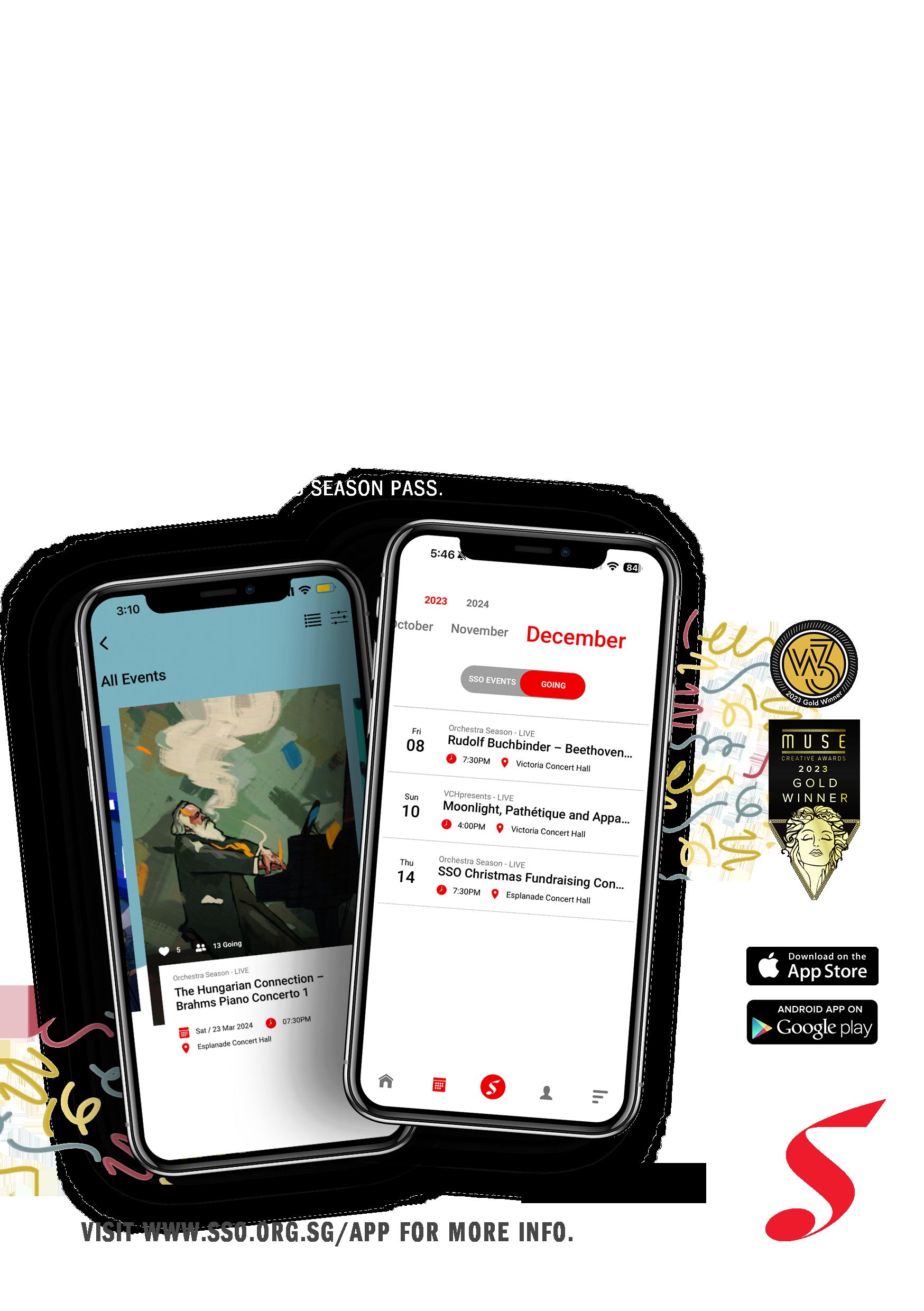
Fri & Sat, 11 & 12 Oct 2024
Victoria Concert Hall
Singapore Symphony Orchestra
Stefan Blunier conductor
Moritz Ernst piano*
HENZE
HAYDN
HAYDN
HAYDN
STRAVINSKY
Fantasia for Strings (SSO Premiere)
Piano Concerto No. 11 in D major* (Performed on 11 Oct)
Piano Concerto No. 4 in G major* (Performed on 12 Oct, SSO Premiere)
Intermission
Symphony No. 59 in A major “Fire” (SSO Premiere)
Pulcinella Suite
(including 20 mins intermission)
Fantasia for Strings (1966) SSO Premiere
Adagio
Funeral march tempo
Espressivo
Allegro–molto meno mosso
Air–Pastorale–Air
Vivace–Epilogue
German Modernist composer Hans Werner Henze led a rather interesting life, having been a soldier for the Third Reich, a prisoner of war, and later in life, living in Italy, an avowed Marxist who wrote compositions in honour of Communist revolutionaries. His output is remarkably diverse in its style, showing influences from serialism, atonality, Middle-Eastern music, jazz, as well as Italian folk music.
The Fantasia for Strings began life as a score for the 1966 German film Der junge Törless, a rather depressing story of the brutal and sadistic lives of a group of boys at an Austrian military academy circa 1900. Henze’s music is angular and harsh, reflecting the merciless aspects of the story, with its elements of psychological, physical, and sexual abuse, and is often intentionally archaic sounding, perhaps to show the heavy burden of centuries of tradition. Uniquely, for the neo-Baroque music, Henze specified the use of renaissance instruments for the film score recording. The score was never published or performed apart from its use in the film, but Henze assembled an abridged version as a concert suite, giving us the Fantasia for Strings.
Scored for string orchestra, Henze uses divisi extensively, making for a rich and complex texture. The work is in, depending on how
one wishes to divide, four, six, or seven movements, but these are played without a break. Perhaps it was the work’s sense of sustained unease that led it to be used for the closing credits of the 1973 film The Exorcist.
Instrumentation strings
World Premiere 1 Apr 1967, Berlin
JOSEPH HAYDN (1732–1809)
Piano Concerto No. 11 in D major (1783)
Vivace
Un poco adagio
Rondo all’ungarese: Allegro assai
Poise and elegance mark the music of Austrian composer Franz Joseph Haydn, and those qualities are exemplified in his keyboard concerti. By 1779, Haydn was feeling bored—nearly twenty years in the exclusive service of the noble Esterházy family had him moving from one country estate to another, each more rural than the next. While his employers were musically sophisticated, and his work included composition, running the orchestra, playing chamber music for and with his employers, and producing operas, all his compositions were the property of the Esterházy family, and he was essentially still a liveried servant.
In 1779, Haydn renegotiated his employment terms and was now permitted to write for others and sell his music to publishers, and this gave him a much needed boost. By 1784, Haydn’s works had reached all over Europe, from Dublin to Constantinople, and his celebrity status was rather akin to that of today’s rock stars.
Published in 1784 by Artaria in Paris, his Piano Concerto No. 11 was likely composed sometime between 1780 and 1783, and is scored for the standard galant orchestra of strings and continuo, with pairs of horns and oboes.
A Vivace opens the work, with the usual softer strings-only statement before winds and brass join in to restate it and
develop it. The piano enters and gives us the theme again, with the ensemble punctuating and shaping the lines, leading into a conversation between soloist and ensemble, and a standard sonata-allegro follows. Despite modulations and occasional chromatic moments, Haydn never loses his trademark poise. A slow movement Un poco adagio is next, in ABA form, and its mood of a gentle afternoon walk in a palace garden is varied with chromaticism in the winds providing some shady respite, while the piano shines and carries the movement.
A Rondo all’ungarese (Hungarian Rondo) caps the work, opening with the soloist giving us the sprightly main idea, which is tossed back and forth. A minor mode section provides the ‘Hungarian’ flavour, with its dissonances, reminding us that Haydn’s employers were Hungarian and that he was based in an area that is now Hungary. Halfway through, a theme that sounds like Three Blind Mice, but in a spicy minor mode, appears – this is from a Serbian/ Croatian folk song Siri kolo, and it should be remembered that Haydn was working in the east of the Holy Roman Empire, where Serbs, Croats, Bosnians, Germans, and Hungarians all rubbed shoulders. This was also a time when ‘exotic’ music was in fashion, and anything east of Vienna was ‘exotic’—Mozart’s famous Turkish March was published in the same year, also by Artaria of Paris.
The work was so popular that it received reprints by at least eight publishers within a decade. In an age before copyright, these later editions generally meant that Haydn received no financial benefit,
but nevertheless these served as free advertisements to further his reputation as the finest composer of his time in Europe, and the concerto remains the most performed of Haydn’s keyboard concerti.
Instrumentation
solo piano, 2 oboes, 2 horns, strings
World Premiere 1784
First performed by SSO 18 May 2007 (Paul Gulda, piano)
JOSEPH HAYDN
Piano Concerto No. 4 in G major (1781) SSO Premiere
Allegro moderato Adagio Rondo: Presto I II III
Also appearing in 1784 was Haydn’s Piano Concerto No. 4 in G major. The work was premiered in Paris at the Concert spirituel that spring by the famous blind Viennese pianist Maria Theresia von Paradis (for whom Mozart would in the same year write his Piano Concerto in B-flat major, K. 465), and would be published that year by Boyer (but with unnecessary additional oboe and horn parts). Little else is known about this particular work, scored lightly for keyboard and strings, but Haydn’s usual elegance shine through.
The delightful opening Allegro moderato is trademark Haydn, full of joy and grace, with the soloist echoing the theme given to us by the strings. Unexpected modulations follow, reminiscent of the works of C.P.E. Bach, whose compositions Haydn studied in the 1760s in Vienna. A relaxed, languid Adagio sets the scene for some rhapsodic and almost intimate conversations between soloist and ensemble, before an orchestral coda ends the movement.
A Rondo-presto in the fashionable ‘exotic’ Hungarian gypsy style is the final movement, and like a Jack-in-the-box, a refrain keeps popping up in unexpected keys. Haydn shows himself a master of invention, taking a simple theme and developing it fully within the space of a few minutes. With this work, Haydn continued to cement his reputation as the finest composer alive.
Instrumentation
solo piano, 2 oboes, 2 horns, strings
World Premiere 1784, Paris
JOSEPH HAYDN
Presto
Andante o più tosto allegretto
Menuet – Trio
Allegro assai
In addition to being the ‘Father of the String Quartet’, Haydn is also known as ‘Father of the Symphony’, a genre he developed by giving the world over 100 examples with great variety between them. Composed in the late 1760s when Haydn was still new to the employ of the Esterházy family, we have no information on the circumstances of the composition of Symphony No. 59 nor its first performance.
As with most of the monikers of Haydn’s symphonies, the nickname of this symphony did not originate with the composer. Two theories exist as to the origin of the ‘Fire’ descriptor. The first is that the energetic first and last movements are rather dramatic and spirited, but they are not particularly more fiery than his contemporaneous works. The second is that several movements were later used as incidental music for a stage production of a play named Die Feuersbrunst (‘The Conflagration’), performed at Eszterháza, the country estate of the Esterházy family in the 1770s. Indeed, a manuscript of the symphony, though not in Haydn’s hand, survives from this time, with the title ‘Feuer Sinfonia’ (‘Fire Symphony’).
The symphony opens Presto with great blazing energy, reminiscent of the battle arias from Vivaldi’s operas. One could think of a massive inferno with rushing winds, or even a storm at sea, and it is tempting to see this as an early happy example of the
Sturm und Drang style that was to become Haydn’s trademark later on. The great towering fire goes through development and quietens to a steadier flame at the end. In the second movement, Haydn gives us an Andante o più tosto allegretto, but surprises us with a minuet first played by the strings who are then joined by oboes and horns. Unusually sombre, the slow movement creeps along in A minor, with the footsteps of a stalker, as the chromatic sprinklings and horn punctuations providing an element of menace.
The third movement Menuet–Trio gives us the Minuet proper, but takes the A minor theme from the previous movement and gives it a major-key facelift. The middle Trio is marked by swirling strings—perhaps Haydn was influenced by the gypsy fiddling he would have heard in the countryside around the Esterházy family’s Hungarian estates? Horn calls reminiscent of hunting themes start the final movement Allegro assai, oboes rollicking away together with the horns before boisterous strings join in and we’re off on a madcap ride through the countryside. Horn calls and oboe responses punctuate the ride, giving it all a festive atmosphere, but before we know it, the short movement comes to an end, leaving us wanting more.
Instrumentation
2 oboes, bassoon, 2 horns, harpsichord, strings
World Premiere unknown
Pulcinella Suite (revised, 1949)
Sinfonia
Serenata
Scherzino
Tarantella
Toccata
Gavotta con due variazioni
Vivo
Minuetto – Finale
An icon of ‘modern music’, Stravinsky cultivated an image of himself as an enfant terrible through his unrelenting dedication to innovation and revolution in musical style. It often surprises audiences to learn that Stravinsky, who could read Latin, had a deep interest in Neo-Thomistic philosophy (with its roots in mediaeval Latin theology), displayed Byzantine icons in his study, wrote a body of sacred music for church services, and returned to devout practice of his Russian Orthodox Christian faith later in life while living in France — perhaps as a portable sign of ‘Russianness’ and a reminder of a bygone age.
With this, Stravinsky’s interest and familiarity with earlier forms becomes easier to understand. When in 1919 the conductor Ernest Ansermet wrote to Stravinsky, it was in regard to a project requested by Sergei Diaghilev, impresario of the Ballets Russes. Diaghilev had requested a ballet with 18th century costumes and commedia dell’arte libretto, with music then believed to have been composed by Italian Baroque composer Giovanni Battista Pergolesi. Stravinsky was initially reluctant, but after studying the scores, realised he could utilise this material but arranging it in a distinctly modern style, giving us Pulcinella. Pulcinella
is one of the stock comedic characters in Italian commedia dell’arte, a sometimes bawdy semi-improvised colourful form of Italian street musical theatre still performed today, and was the origin of the British puppet characters Punch and Judy.
The ballet was eventually produced in Paris in 1920, with costumes and sets designed by no less a celebrity than Pablo Picasso, and included vocal parts for solo soprano, tenor, and bass. The work was an immense success, and in 1922 Stravinsky extracted eight movements to form a suite. Though musicology has since revealed that much of the music had been misattributed to Pergolesi, the artistic quality of Stravinsky’s work has ensured the Pulcinella Suite a continued place in concert repertoires.
The complicated plot of the ballet is beyond the scope of these notes but a brief familiarity with the themes of commedia dell’arte helps with appreciating the themes in the music: romantic courtship, clownish adventures, mistaken identities, disguises, feigned deaths, breakups, tearful reconciliations, but at the end everyone lives happily ever after.
Notes by Edward C. Yong
Instrumentation
2 flutes (1 doubling on piccolo), 2 oboes, 2 bassoons, 2 horns, trumpet, trombone, strings
World Premiere 22 Dec 1922, Boston
First performed by SSO 9 Jul 1982
Fri & Sat, 25 & 26 Oct 2024
Victoria Concert Hall
Singapore Symphony Orchestra
Treble Voices of the Singapore Symphony Chorus & Youth Choir
Hans Graf Music Director
Eudenice Palaruan Choral Director
Ingrid Fliter piano1
Maureen Thomas actress/narrator 2
Adrian Tan lighting designer 2
Leong Shan Yi production stage manager 2
BEETHOVEN MENDELSSOHN
Piano Concerto No. 3 in C minor, Op. 371
Intermission
A Midsummer Night’s Dream, Op. 612
Kaitlyn Kim, fairy 1
Giselle Lim, fairy 2 (25 Oct)
Ng Sheh Feng, fairy 2 (26 Oct)
Concert Duration: approximately 2 hrs 25 mins (including 25 mins intermission)
Dedicated to

Piano Concerto No. 3 in C minor, Op. 37 (1800)
I
II III
Allegro con brio
Largo Rondo. Allegro
The opening lyrics to the Pokémon theme (“Gotta Catch ‘Em All!”), I wanna be the very best / Like no one ever was may as well have been Beethoven’s life motto. With everything that he did, he aimed high, defied conventions and broke new ground. Refusing to be a servant of the court, he decided to organise ‘benefit concerts’ where the beneficiary was himself. The concerts were to serve a two-fold purpose: make him some money, and introduce his music to the Viennese public. Up until then, he had only achieved the status of the best virtuoso pianist and improviser in all of Vienna through multiple piano duels organised by the nobility.
The first of such concerts took place at the Burgtheatre in Vienna on 2nd April, 1800, comprising a Mozart symphony, two pieces from Haydn’s Creation, Beethoven’s First Symphony, his Septet, as well as “A grand Concerto for the pianoforte, played and composed by Herr Ludwig van Beethoven”, which was probably the Piano Concerto No. 1 in C major, Op. 15.
The Piano Concerto No. 3 in C minor, Op. 37 was to have been on that concert programme too, but Beethoven had not completed it by that time. Other lucrative projects took precedence over the concerto, such that by the time of its premiere three years later in yet another mammoth-sized benefit concert, it was still barely completed, with not all the pages written out. Ignaz von
Seyfried, Beethoven’s pupil and page-turner for the concert, recounts,
“I saw empty pages with here and there what looked like Egyptian hieroglyphs, unintelligible to me, scribbled to serve as clues for him. He played most of his part from memory, since, obviously, he had put so little on paper. So, whenever he reached the end of some invisible passage, he gave me a surreptitious nod and I turned the page. My anxiety not to miss such a nod amused him greatly and the recollection of it at our convivial dinner after the concert sent him into gales of laughter.”
The key of C minor was frequently used by Beethoven — notably in his Pathetique Sonata and later on in the Fifth Symphony. In the words of musicologist Paul Schiavo, it represented Beethoven’s association with pathos and struggle, and is reserved for his most dramatic music.
The Third Concerto is the bridge between Beethoven the composer who looked up to Mozart, and a more mature Beethoven who had established his personal style with economy of motifs, bold wanderings into unrelated keys, and dramatic tension that give way to tender and peaceful moments in a heartbeat.
Dark and brooding, the first movement opens with a theme that is often compared with Mozart’s K. 491 piano concerto —
also in the key of C minor. The opening orchestral exposition introduces the first theme, a drum-like rhythmic idea that enters softly and leads into the second theme, a singing melody in the relative key of E-flat major. The brooding opening mood then returns, in preparation for the soloist’s dramatic entrance, going through both themes with virtuoso passagework. The development section takes the listener through a conversation between soloist and orchestra based on the main theme, fragmented but not entirely deconstructed. The main themes are reprised and lead into the cadenza, where Beethoven would have improvised on the spot during the performance but later on wrote down a version for pianists to play. After the traditional trills which signal the end of the cadenza, the orchestra re-enters with the timpani quietly playing the opening rhythmic motif, bringing the movement to a stormy conclusion.
In a complete change of scenery, the second movement is set in the distant key of E major, with an opening that “must sound like a holy, distant and celestial Harmony”, in the words of Beethoven’s student Carl Czerny. It is the piano alone that introduces this soulful melody, before the orchestra later takes it up. Later on, the flute and bassoon play fragments while the piano weaves in between with arpeggios, bringing the music back to the main theme
and the peaceful closing on an E major chord.
In a skilful manoeuvre, Beethoven takes the G-sharp of the ending chord, turning it into an enharmonic A-flat that the soloist uses to bring back the music into C minor for the rondo. The spirited rondo has its fair share of drama juxtaposed with episodes brimming with Beethovenian humour, and even a fugue based on the main theme. Leading the audience to think that the fugue would conclude in C minor, Beethoven ups the music a semitone to an A-flat and the piano wanders off into the key of E major, recalling the slow movement. Right at the end, the music switches into a cheerful C major coda, with the soloist and orchestra racing each other to a triumphant end.
Notes by Natalie Ng
Instrumentation
solo piano, 2 flutes, 2 oboes, 2 clarinets, 2 bassoons, 2 horns, 2 trumpets, timpani, strings
World Premiere 5 Apr 1803, Vienna
First performed by SSO 22 Nov 1979 (Ivan Moravec, piano)
Overture and Incidental Music to A Midsummer Night’s Dream, Op. 21/61 (1826/1842)
It was in July 1826 when Mendelssohn first discovered the works of William Shakespeare, whose plays had been readily available in German. The supernatural tinge and comic vivacity of A Midsummer Night’s Dream fascinated him, and soon inspired the budding composer to set it to music. The composer was all of 17 years old when he completed this Overture in August. The work has remained steadfast in popularity since its public premiere in February 1827 in Stettin (present-day Szczecin, Poland) where the composer was also a soloist in his own A-flat major concerto for two pianos and Weber’s Konzertstück in F minor. He even joined the first violins after the intermission for Beethoven’s Ninth Symphony.
16 years later, when the need for incidental music — music used in a play to complement action or atmosphere — for a new production of A Midsummer Night’s Dream arose through a commission from King Frederick William IV of Prussia, Mendelssohn wrote an additional 13 numbers to follow the Overture. These include musical realisations of verses/ songs in the play, plus orchestral depictions of wanderers lost in the forest, dreamy nocturnes and comical theatrics. In concert halls, the incidental music is not heard as often as the Overture, but outside of the hall, the Wedding March is instantly recognisable all over the world. Even so, orchestras usually perform the incidental music in a cleaned-up suite — but tonight, you will hear the many musical sprinkles of fairy dust and oodles of comic fun that are unique to a complete performance.

Title page of the 1600 edition of A Midsummer Night's Dream, printed by James Roberts.
Despite the separation of 16 years between their creation, there’s no sign of any disparity between the incidental music and the Overture, with Mendelssohn closing the finale with the exact same chords with which he opens the Overture, as if he himself has finally awakened from a dream.
The Overture is an orchestral tour-de-force for a composer so young, an encapsulation of youthful vibrance, bewitching storytelling and elegant humour all wrapped in the finesse of classical writing touched by Romantic expressivity. It opens with its signature four magic chords followed by the fairy skitter of strings. This is a musical figure you will hear throughout the incidental music, signalling the entry of fairies. It is just another familiar device to the then 17-year-old who had already written 15 remarkable string symphonies. Mozart would’ve been proud of him, as much as he surely would have approved of the bold donkey hee-haws and operatic lovers’ sighs that Mendelssohn cleverly depicts.
1. Scherzo
To the same pixie woodwind from the Overture, Puck enters. Also known as Robin Goodfellow, Puck is the servant, jester and right-hand fairy of Oberon, King of the Fairies. As a leading character and occasional narrator of the play, Puck famously (and accidentally) triggers key events in A Midsummer Night’s Dream, besides being capable of circling the Earth in 40 minutes.
2. L’istesso tempo
In a forest outside Athens, Puck explains to another fairy that Oberon is angry with the queen, Titania, because of her refusal to give up a magical changeling boy she dotes on, to be his servant.
March of the Fairies
A miniature march precedes the appearance of the Fairy King and Queen. While called a “march”, the music is anything but martial — Mendelssohn is too clever not to take advantage of the whimsically fantastical setting. His march is the stuff of scurrying excitement and dusky anticipation, with triangle and cymbals refined to a delicate chiming in the background.
Ill met by moonlight, proud Titania. - OBERON
Oberon and Titania meet and bicker in the forest, before she leaves in a huff. The Fairy King then beckons Puck to find a magic flower whose juice, when dropped into the eyes of a sleeping individual, will make him or her fall madly in love with the first creature they see upon waking.
As Oberon muses over his plan, he overhears Demetrius and Helena arguing nearby. Watching invisibly, he resolves to help Helena.
3. Song with Chorus
Over at a river bank where the wild thyme blows, Titania bids her fairies to sing her to sleep. But instead of just a gentle lullaby, the music is full of buzzing creepy-crawlies and sinuous snakes, wriggling with woodwinds and violins. The fairies melodiously chase them away from Titania’s bower.
You spotted snakes with double tongue, Thorny hedgehogs, be not seen.
Newts and blindworms, do no wrong.
Come not near our fairy queen.
Hence, away! Hence, away!
Philomel, with melody
Sing in our sweet lullaby.
Lulla, lulla, lullaby, lulla, lulla, lullaby.
Never harm
Nor spell nor charm
Come our lovely lady nigh. So good night, with lullaby.
Weaving spiders, come not here.
Hence, you long-legged spinners, hence!
Beetles black, approach not near;
Worm nor snail, do no offence.
Hence, away! Hence, away!
4. Andante
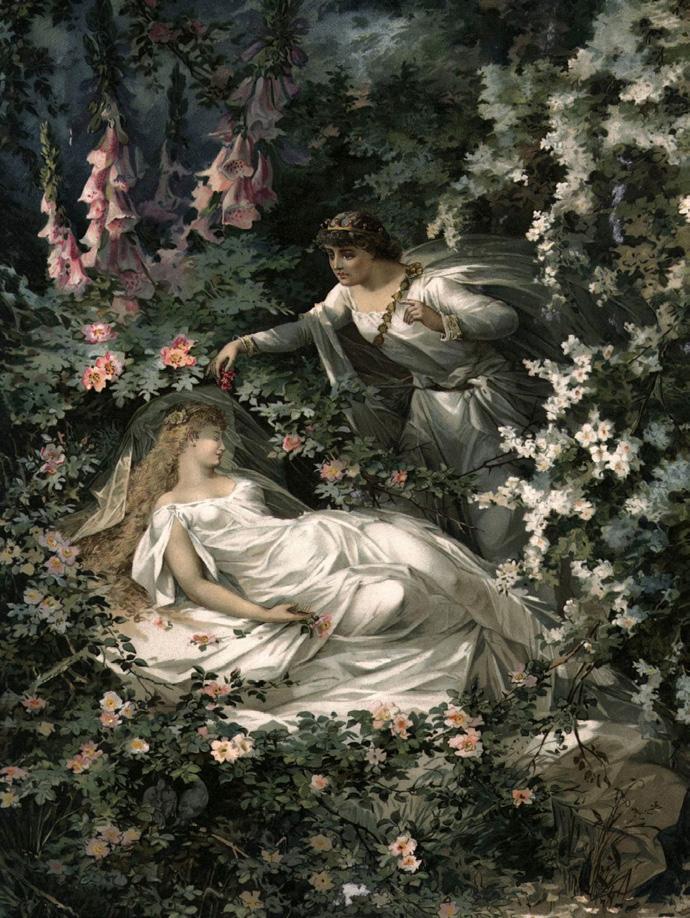
Oberon charms Titania - illustration by Julius Hoeppner, 1888.
To the secretive hush of muted violins, Oberon steals onto the scene and drops the magic juice into Titania’s sleeping eyes.
Meanwhile, following Oberon’s instruction, Puck slips into the woods to look for the “disdainful youth” Demetrius. However, he mistakes a sleeping Lysander for Demetrius and enchants his eyes instead. When Lysander is awakened by Helena, he inadvertently falls in love with her.
5. Intermezzo
The disorientating exchange between woodwinds and strings in this music creates an atmosphere of anxiety and desperation, as Hermia loses herself in the woods looking for Lysander.
6. Allegro
Puck encounters the “mechanicals”, an archaic reference to craftsmen such as Nick Bottom the weaver. They are rehearsing a play for Duke Theseus on his wedding day. Puck mischievously transforms Bottom’s head into that of a donkey, which sends his frightened companions running away. Feeling spooked, Bottom begins to sing to keep his wits. Unbeknownst to him, Titania is sleeping nearby.
The orchestra begins to play the four familiar magic chords as Titania stirs… except the harmonies go awry, symbolising her distorted vision.
What angel wakes me from my flowery bed? I pray thee, gentle mortal, sing again: Mine ear is much enamour’d of thy note; So is mine eye enthralled to thy shape.
- TITANIA

Puck returns to Oberon to report his work. Oberon is delighted that Titania has been made an ass of herself but is taken aback when he realises Puck’s mistake with Lysander. Oberon commands Puck to find Helena while he charms Demetrius’s eyes. Demetrius wakes up just as Lysander and Helena appear, resulting in both men now in love with her, to her utter disbelief.
Oberon decides that things have now gone a little too far and bids Puck to use an antidote to restore Lysander’s wits. Puck watches the four lovers wear themselves out lost in the forest. Mendelssohn’s frantic music gradually loses its energy as Puck casts a spell to put them all to sleep.
7. Nocturne
Mendelssohn’s peaceful nocturne is one of the most representative of its kind from the Romantic era, with its serene duet for horns and bassoons. A momentary dream stirs in the middle of the night, but is soon soothed by slumber.
8. Andante
His heart softening, Oberon lifts the flower’s magic from Titania with an upward flourish of violins. The royal fairy couple are reunited in amity, and Oberon resolves to help wed every pair of lovers in jollity.
9. Wedding March
Opening majestically with its famous brass fanfare, Mendelssohn’s Wedding March has long been a melody associated with marriage. It became popular when it was chosen by Victoria, the Princess Royal, at her wedding in 1858. Her mother Queen Victoria was a great admirer of Mendelssohn and his music.
Back in Athens, the Wedding March celebrates the play’s triple wedding of Lysander and Hermia, Demetrius and Helena and their hosts Duke Theseus and Hippolyta.
10. Allegro comodo (Fanfare) - Funeral March
A mock-heroic fanfare sounds as it is finally the mechanicals’ turn to stage their play, Pyramus and Thisbe, based on the ill-fated couple from Ovid's Metamorphoses. The Duke's master of ceremonies, Philostrate, calls the play "some ten words long" but "by ten words, my lord, it is too long". As “tragical" as the story may be, in their inept hands, the theatrical helplessness of the workmen will turn it into a comedy.
11. Dance of the Clowns
Keeping with the spirit, the mechanicals conclude with a jolly “bergomask” dance. Mendelssohn reminds us who’s the donkey by reprising the “hee-haw” motif from the Overture.
12. Finale
It is midnight, and Theseus invites the couples to retire to bed. As night deepens, Oberon, Titania and the fairies appear to perform a final blessing on the household.
CHORUS
Through the house give glimmering light, By the dead and drowsy fire; Every elf and fairy sprite Hop as light as bird from brier; And this ditty, after me, Sing and dance it trippingly.
TITANIA
First, rehearse your song by rote, To each word a warbling note: Hand in hand, with fairy grace, Will we sing, and bless this place.
CHORUS
Trip away. Make no stay. Meet me all by break of day.
Puck delivers A Midsummer Night’s Dream’s celebrated epilogue, seeking your forgiveness if the play you’ve just witnessed has not pleased you. 16th century Shakespeare breaks the fourth wall, with an imaginary character crossing the sphere of the stage to speak to you, the audience. Puck/Shakespeare invites you to imagine that what you have just witnessed is but a dream. With his four glowing chords, Mendelssohn bids you awake.
If we shadows have offended, Think but this, and all is mended—
That you have but slumbered here
While these visions did appear. And this weak and idle theme, No more yielding but a dream, Gentles, do not reprehend. If you pardon, we will mend. And, as I am an honest Puck, If we have unearnèd luck
Now to ’scape the serpent’s tongue, We will make amends ere long.
Else the Puck a liar call. So good night unto you all. Give me your hands if we be friends, And Robin shall restore amends.
Instrumentation
sopranos, treble voices, 2 flutes, 2 oboes, 2 clarinets, 2 bassoons, 2 horns, 3 trumpets, 3 trombones, tuba, timpani, triangle, cymbals, strings
World Premiere 14 Oct 1843, Potsdam
First performed by SSO 27 Jun 1981
We would like to express our deepest appreciation to the following individuals and organisations who support our mission to create memorable shared experiences with music in the past year.
Without your support, it would be impossible for the SSO to continue to strive for artistic excellence and touch the hearts of audiences.
PATRON SPONSOR
Tote Board Group
(Tote Board, Singapore Pools & Singapore Turf Club)
MAESTRO CIRCLE
Mr & Mrs Goh Yew Lin
Stephen Riady Group of Foundations
Estate of Tan Jiew Cheng
Temasek Foundation
The HEAD Foundation
SYMPHONY CIRCLE
Dr & Mrs Antoine & Christina Firmenich
Holywell Foundation
Lee Foundation
Lee Li Ming
Paige Parker & Jim Rogers
Jacqueline Yeh
Yong Hon Kong Foundation
Anonymous (2)
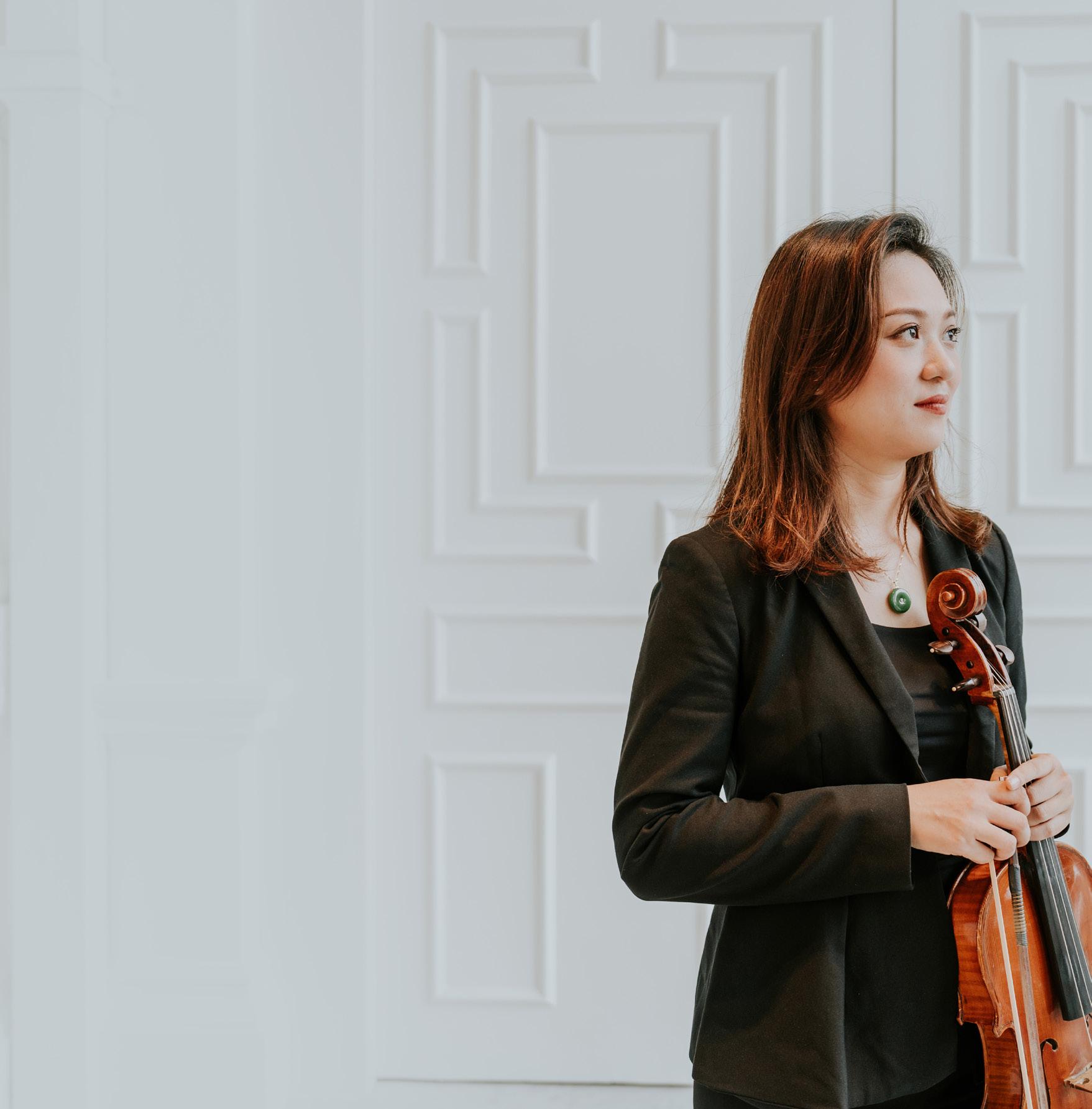
CONCERTO CIRCLE
Prof Chan Heng Chee
Cara & Tamara Chang
Geraldine Choong & Dennis Au
Elaine and Eduardo Saverin Foundation Ltd
Embassy of France in Singapore
Far East Organization
Christopher Fussner
Geh Min
Miriam & Merle Hinrich
IMC Group Asia (S’pore) Pte Ltd
Karim Family Foundation
Kris Foundation
Frans & Marie-Pierre Mol
Neo Group Limited
Paul & Lena Ng
Andreas & Doris Sohmen-Pao
Dr Edwin Tan
UOB
Geoffrey & Ai Ai Wong
Wong Hong Ching
Dr Thomas & Mrs Mary Zuellig
Odile & Douglas Benjamin
BINJAITREE
BreadTalk Group
Lito & Kim Camacho
Cavazos Tinajero Family
Cham Gee Len
Prof Cham Tao Soon
Alan Chan
Vivian P J Chandran
Chen Xiaoyan
Chng Hak-Peng
Daniel Choo & Family
Chopard Asia Pte Ltd
Dr & Mrs Choy Khai Meng
Prof Arnoud De Meyer
Energeo Systems Pte Ltd
Karen Fawcett & Alisdair Ferrie
FRED Jewelry
Dorian Goh & Rathi Ho
Goh Swee Chen
Haidilao Hotpot
Hong Leong Foundation
Illumia Medical Pte Ltd
Vanessa & Darren Iloste
JCCI Singapore Foundation
Ross & Florence Jennings
Jin Lu
Vivian Kao & Shou Zi Chew
Jeffrey Khoo
Dr & Mrs Adrian Koh
Mr & Mrs Koh Chye Hock
Krishnan Family
Kenneth Kwok
Mark Lee & Kelly Keak
Lee Ming San
Colin & Janet Leong
Leong Wai Leng
LGT Bank (Singapore)
Liew Wei Li
Lim Boon Heng
Mavis Lim Geck Chin
Marina Bay Sands
NEON Global
NSL Ltd
Christina Ong
PCS Pte Ltd
Poh Khim Hong
Prima Limited
Xu Ren
Priscylla Shaw
Martin Siah & Wendy Long
Prof Gralf & Silvia Sieghold
Sirivadhanabhakdi
Eugene Sng
Tan Meng Cheng Ivan
Joy & Han Li Toh
Tow Heng Tan
Tower Capital Asia
V3 Group Limited (OSIM)
Watson Farley & Williams LLP
Woh Hup (Private) Limited
Kevin T Yap
Grace Yeh
Yong Ying-I
Guy Hentsch & Geoffrey Yu
Zeng Fuzu
Zeng Liqing
Anonymous (5)

Marcelo Viccario Achoa & Silvia Bordoni
Su Pin & Mervin Beng
John & Eliza Bittleston
Bryan Carmichael
Hartley & Hong Lynn Clay
Gan Seow Ann
Goh Hui Kok Michael
Liwen & Steven Holmes
Rebecca Hong
Katherine Kennedy-White
Maisy Koh
Lorinne Kon
Mr & Mrs Paterson Lau
Leong Wah Kheong
Ang Jian Zhong
Lawrence & Celeste Basapa
Cheong Hee Kiat
Evelyn Chin
Chor Siew Chun
Adrian Chua Tsen Leong
Ee Kim Lock
Gallery Nawei Pte Ltd
The Gangoso Family
Jerry Gwee
Ho Bee Foundation
Hwang Chih Ming
Sylvie Khau
Belinda Koh
In Memory of Timothy Kok Tse En
Winston & Valerie Kwek
Jeanne Lee
Jennifer Lee
Sean Lee
Gin & Douglas Leong
Caroline Lim
Charmaine Lim

Darren Lim & En Yu Tan
D-Y Lin
Michelle Loh
Joanna Ludkiewicz & Robert Hunziker
Kishore & Anne Mahbubani
Christopher & Clarinda Martin
msm-productions
Ms Oang Nguyen & Dr Dang Vu
SC Global Developments Pte Ltd
Dr June & Peter Sheren
Tan Seow Yen
G L Wee
Chuin Wei Yap
Anonymous (6)
Dr Victor Lim
JN Loh
Jesher Loi
Francoise Mei Meng
Stephanie Mualim
Debra Ng
Kenneth Oo
Esmé Parish & Martin Edwards
Terese Poh
Ian & Freda Rickword
Audrey Ruyters
Farhana Sharmeen
The Sohn Yong Family
Julian Tan
Tang See Chim
Anthony Tay
Amanda Walujo
Eric Wong
Wong Yan Lei Grace
Wu Peihui
Anonymous (5)
Hyder Ahmad
Aloha Dental Clinic
Adeline Ang
Ang Seow Long
Tatiana Antonova & Stanislav Miroshnichenko
Anthony & Chloe Tan from ACE Team Foundation
BDA Partners Pte Ltd
Hans Michael Brandes
John Cai
Pauline Chan
Chang Chee Pey
Chang Julian
Jeanie Cheah
Cynthia Chee
Y C Chen
Zhihong Chen
Cheng Eng Aun
Andrew Cheong Zhiren
Dr Chew Chee Tong
Faith Chia
Chin Soon Yenn
Anthony Chng
Pamela Chong
Ruby Chong
Tiffany Choong & Shang Thong Kai
Clarissa Chow
Belinda Chua
Jennie Chua
Pierre Colignon
CP
Jeremy Ee
Jamie Lloyd Evans
J-P & Colette Felenbok
John & Pauline Foo
Dr Foo Swee Sen
Gan Yit Koon
Soumyadip Ghosh
Goh Chiu Gak
Mrs Goh Keng Hoong
Prof Goh Suat Hong
Yvette Goh
Heinrich Grafe

Gu Zhenhao
Parthesh Gulawani
Ilya Gutlin
Winston Hauw
Henry & Tiffany
Nishioka Hiroyuki
Dr Ho Su Ling
In memory of 黄招娣 (Huang Zhao Di)
Arjun Jolly & Priyanka Nayar
Claire & Ian Jones
Ad Ketelaars
Khim
Elizabeth Khoo
Ernest Khoo
Dr & Mrs Khoo Teng Kew
Dr Khoo Wei Ming
Khor Cheng Kian Kye
Colin Lang
Dr & Mrs Winson Lay
SuYin L
Lee Hyunsun
Kristen Lee
Dr Norman Lee
Lee Wei Jie
Voon S Leong
Wendy Leong Marnyi
Li Danqi & Liu Yi
Derek Lim
Edith & Sean Lim
Suzanne Lim
Lim Yuin Wen
Rachel Lin
Ling Yang Chang
Low Boon Hon
Alwyn Loy
Fabian Lua
Benjamin Ma
April Mak
Andre Maniam
Mattopher
McCann Family
Minwei
Dr Tashiya Mirando
Devika & Sanjiv Misra
John Morley
Ngiam Shih Chun
Mdm Ngo Hwee Bee
Ong Chee Siong
Ong Kay Jin Jason
Xinyi Ong
Victor Ow
Phua Ching Shyen
Pigar & William
Robert Khan & Co Pte Ltd
Danai Sae-Han
Kadir Satar
Hisaaki Sato
Sayawaki Yuri
Marcel Smit & Hanneke Verbeek
Soh Leng Wan
Ron & Janet Stride
Superb Cleaning Pte Ltd
Andrew & Jacqueline Tan
Casey Tan Khai Hee
Christine Tan & Jeremy Ting
Dr Giles Tan Ming Yee
Gillian & Daniel Tan
Gordon HL Tan
Jean Tan
Tan Kok Huan
Dr Tan Lay Kok
Michelle Tan
Min Tan
Dr Pamela Tan
Tan Peng Peng
Tan Siew Ling Celine
Linda Tan Soo
Tan Yee Deng
Tay Kim Ann
David Teng
Teo Eng Chai
Teo Kien Boon
Kyra Teo
Teo Wee Poh
Alessandro Tesei
Alicia Thian & Brian Bonde
Alan & Akashnee Thompson
Yang Tian
The Tomsik Family
Wang Lei & Gao Bo
Wang Meng
Wang Pei Zhong
Tania Wee
Kris Wiluan
Dr Wong Hin Yan
Jinny Wong
Wicky Wong
Jennifer S Wu
Valerie Wu
Xiao Li
Elaine Xu
Yan Xia
Yeow Ooh Teng
Lillian Yin
Yong Seow Kin
Zhang Zheng
Zheng Hongbo
Zhu Yulin
Anonymous (41)

This list reflects donations that were made from 1 Oct 2023 to 30 Sep 2024. We would like to express our sincere thanks to donors whose names were inadvertently left out at print time.
The Singapore Symphony Group is a charity and a not-for-profit organisation. Singapore tax-payers may qualify for 250% tax deduction for donations made. You can support us by donating at www.sso.org.sg/donate or www.giving.sg/sso.
SUPPORT THE SSO
How can you help?
While SSO is supported partially by funding from the Singapore government, a significant part can only be unlocked as matching grants when we receive donations from the public. If you are in a position to do so, please consider making a donation to support your orchestra – Build the future by giving in the present.
As a valued patron of the SSO, you will receive many benefits.
COMPLIMENTARY TICKETS*
Subscription/ Chamber and Organ /Family/ SIPF Gala/Christmas/ Pops
SSO Special Gala Concerts
DONOR RECOGNITION & PUBLIC ACKNOWLEDGEMENT
Concert booklets and website
Patron of the Arts Nomination
Donors’ Wall at VCH
OTHER BENEFITS
Invitation to special events
Donations of $100 and above will entitle you to priority bookings, and discounts^ on SSG Concerts. For tax residents of Singapore, all donations may be entitled to a tax deduction of 2.5 times the value of your donation.
*Complimentary ticket benefits do not apply to Esplanade & Premier Box seats, or supporters who give through a fundraising event.
^Discounts are not applicable for purchase of Esplanade & Premier Box seats.
Through the SSO and its affiliated performing groups, we spread the love for music, nurture talent and enrich our diverse communities.
The Singapore Symphony Orchestra is a charity and not-for-profit organisation. To find out more, please visit www.sso.org.sg/support-us, or write to Nikki Chuang at nikki@sso.org.sg
We recognise major gifts that help sustain the future of the Singapore Symphony Group. The recognition includes naming of a position in the SSO or in our affiliated performance groups such as the Singapore National Youth Orchestra and the Singapore Symphony Choruses.
SSO CONCERTMASTER GK GOH CHAIR
In July 2017, the SSO established the GK Goh Chair for the Concertmaster. Mr Goh Geok Khim and his family have been long-time supporters of the national orchestra. We are grateful for the donations from his family and friends towards this Chair, especially Mr and Mrs Goh Yew Lin for their most generous contribution.
Mr Igor Yuzefovich was the inaugural GK Goh Concertmaster Chair. The position is currently vacant.
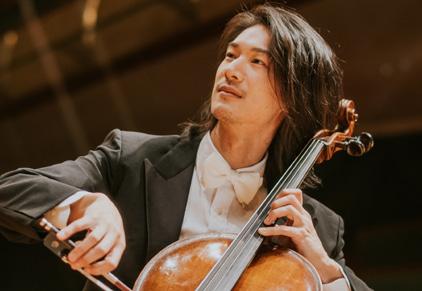
NG PEI-SIAN PRINCIPAL CELLO
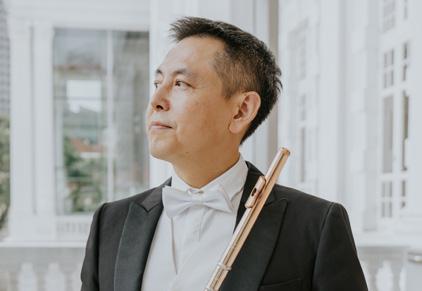
JIN TA PRINCIPAL

SSO PRINCIPAL CELLO
THE HEAD FOUNDATION CHAIR
In recognition of a generous gift from The HEAD Foundation, we announced the naming of our Principal Cello, “The HEAD Foundation Chair” in November 2019. The Chair is currently held by Principal Cellist Ng Pei-Sian.
SSO PRINCIPAL FLUTE
STEPHEN RIADY CHAIR
In recognition of a generous gift from Dr Stephen Riady, we announced in May 2022 the naming of our Principal Flute, “Stephen Riady Chair”. The position is currently held by our Principal Flutist Jin Ta.
SSO PRINCIPAL VIOLA
TAN JIEW CHENG CHAIR
In recognition of a generous gift from the Estate of Tan Jiew Cheng, we announced in February 2024 the naming of our Principal Viola, “Tan Jiew Cheng Chair”. The position is currently held by our Principal Violist Manchin Zhang.
For more information, please write to director_development@sso.org.sg.
CORPORATE PATRONAGE

HEARTFELT THANKS TO OUR CORPORATE PATRONS
Temasek Foundation
The HEAD Foundation
Stephen Riady Group of Foundations
Holywell Foundation
Lee Foundation
Yong Hon Kong Foundation
Aquilus Pte Ltd
Elaine and Eduardo Saverin Foundation Ltd
Embassy of France in Singapore
IN-KIND SPONSORS
Raffles Hotel Singapore
SMRT Corporation
Singapore Airlines
Conrad Centennial Singapore
Symphony 924
Form a special relationship with Singapore’s national orchestra and increase your brand recognition among an influential and growing audience.
We provide our Corporate Patrons with impressive entertainment and significant branding opportunities. Through our tailored packages, corporates may benefit from:
• Publicity and hospitality opportunities at an SSO concert or your private event,
• Acknowledgement and mentions in SSO’s key publicity channels,
• National Arts Council (NAC) Patron of the Arts nominations,
• Tax benefits.
Packages start at $10,000 and can be tailored to your company’s branding needs.
We partner with various corporates through tailored in-kind sponsorship and exchange of services. Current and recent partnerships include Official Hotel, Official Airline, and we offer other exciting titles.
For more details, please write to Chelsea Zhao at chelsea.zhao@sso.org.sg.
CHAIR
Goh Yew Lin
BOARD OF DIRECTORS
Chang Chee Pey
Chng Kai Fong
Andress Goh
Kenneth Kwok
Clara Lim-Tan
Jesher Loi
Lynette Pang
Prof Qin Li-Wei
Jovi Seet
Farhana Sharmeen
Doris Sohmen-Pao
Prof Peter Tornquist
Geoffrey Wong
Andrew Yeo Khirn Hin
EXECUTIVE & NOMINATING COMMITTEE
Goh Yew Lin (Chair)
Chng Kai Fong
Lynette Pang
Geoffrey Wong
HUMAN RESOURCES COMMITTEE
Doris Sohmen-Pao (Chair)
Jesher Loi
Prof Qin Li-Wei
Heinrich Grafe*
Carmen Wee*
FINANCE & INVESTMENT COMMITTEE
Geoffrey Wong (Chair)
Andress Goh
Chua Keng Hong*
Alex Lee*
AUDIT & RISK COMMITTEE
Jovi Seet (Chair)
Prof Peter Tornquist
Andrew Yeo Khirn Hin
Ryan Siek*
COMMUNITY & YOUTH ENGAGEMENT COMMITTEE
Clara Lim-Tan (Chair)
Chang Chee Pey
Farhana Sharmeen
Asst Prof Kat Agres*
Cecilia Pang*
SSO MUSICIANS’ COMMITTEE
Mario Choo
David Smith
Wang Xu
Christoph Wichert
Yang Zheng Yi
Elaine Yeo
Zhao Tian
SSO COUNCIL
Alan Chan (Chair)
Odile Benjamin
Prof Chan Heng Chee
Prof Arnoud De Meyer
Dr Geh Min
Heinrich Grafe
Khoo Boon Hui
Liew Wei Li
Lim Mei
Sanjiv Misra
Paige Parker
Dr Stephen Riady
Priscylla Shaw
Prof Gralf Sieghold
Prof Bernard Tan
Dr Tan Chin Nam
Wee Ee Cheong
Yong Ying-I
*co-opted member
CHIEF EXECUTIVE OFFICER
Kenneth Kwok
DEPUTY CEO, PROGRAMMES & PRODUCTION
Kok Tse Wei
DEPUTY CEO, PATRONS & CORPORATE SERVICES
Jenny Ang
CEO OFFICE
Shirin Foo
Musriah Bte Md Salleh
ORGANISATION DEVELOPMENT
Lillian Yin
ARTISTIC PLANNING
Hans Sørensen (Head)
Artistic Administration
Jodie Chiang
Terrence Wong
Jocelyn Cheng
Michelle Yeo
OPERATIONS
Ernest Khoo (Head)
Library
Lim Lip Hua
Wong Yi Wen
Adlina Bte Ashar
Cheng Yee Ki
Orchestra Management
Chia Jit Min (Head)
Charis Peck Xin Hui
Kelvin Chua
Production Management
Noraihan Bte Nordin
Nazem Redzuan
Leong Shan Yi
Asyiq Iqmal
Khairi Edzhairee
Khairul Nizam
Benjamin Chiau
COMMUNITY IMPACT
Community Engagement
Kua Li Leng (Head)
Samantha Lim
Whitney Tan
Lynnette Chng
Choral Programmes
Kua Li Leng (Head)
Chang Hai Wen
Mimi Syaahira
Singapore National Youth
Orchestra
Ramu Thiruyanam (Head)
Tang Ya Yun
Tan Sing Yee
Ridha Ridza
ABRSM
Patricia Yee
Lai Li-Yng
Joong Siow Chong
Freddie Loh
May Looi
PATRONS
Development
Chelsea Zhao (Head)
Nikki Chuang
Sarah Wee
Brandon Lim
PATRONS
Communications, Digital & Marketing
Cindy Lim (Head)
Communications
Elliot Lim
Elizabeth Low
Clairene Tan
Digital & Marketing
Chia Han-Leon
Calista Lee
Myrtle Lee
Hong Shu Hui
Jana Loh
Kashmira Kasmuri
Customer Experience
Randy Teo
Dacia Cheang
Joy Tagore
CORPORATE SERVICES
Finance, IT & Facilities
Rick Ong (Head)
Alan Ong
Goh Hoey Fen
Loh Chin Huat
Md Zailani Bin Md Said
Human Resources & Administration
Valeria Tan (Head)
Janice Yeo
Fionn Tan
Netty Diyanah Bte Osman




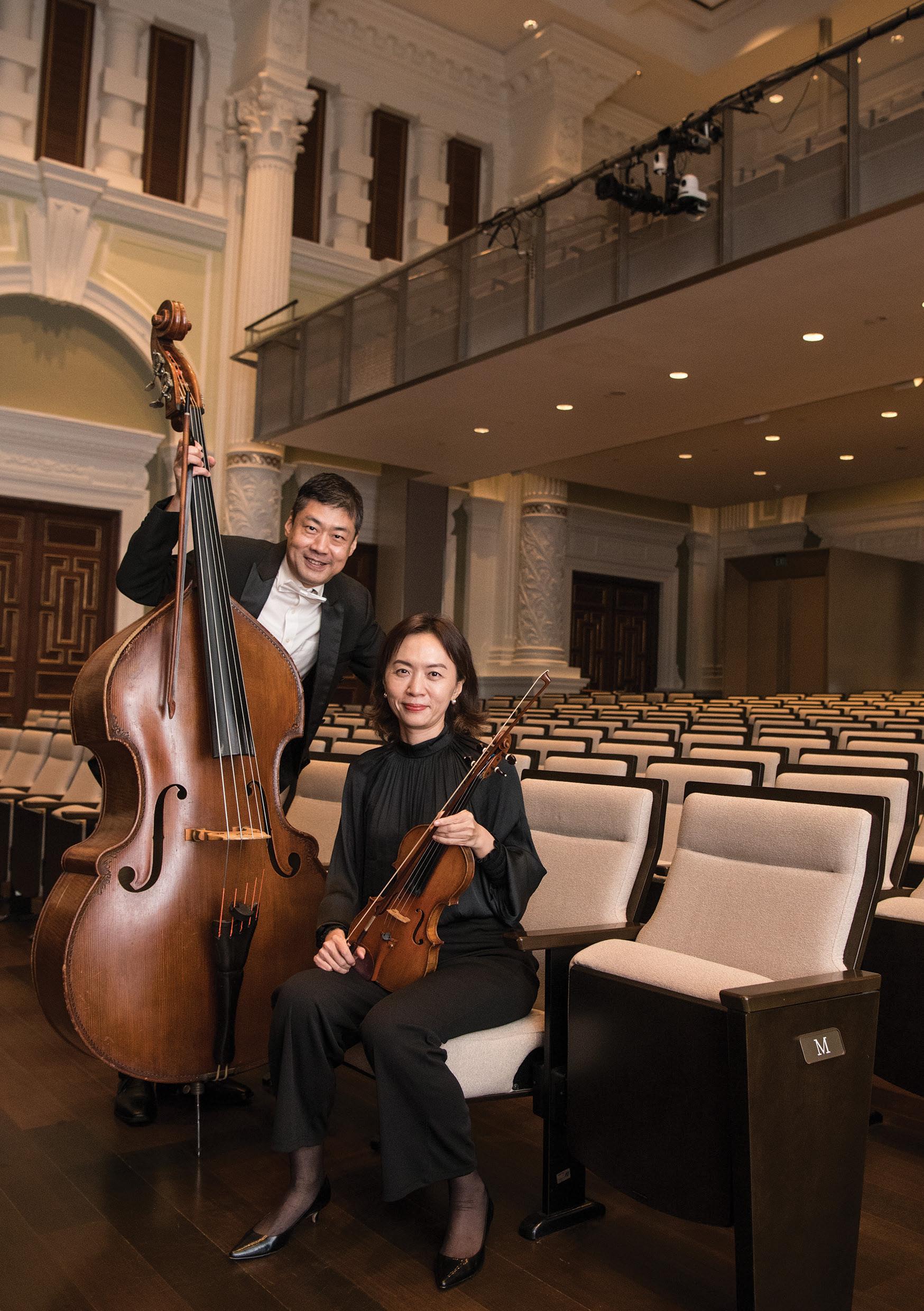
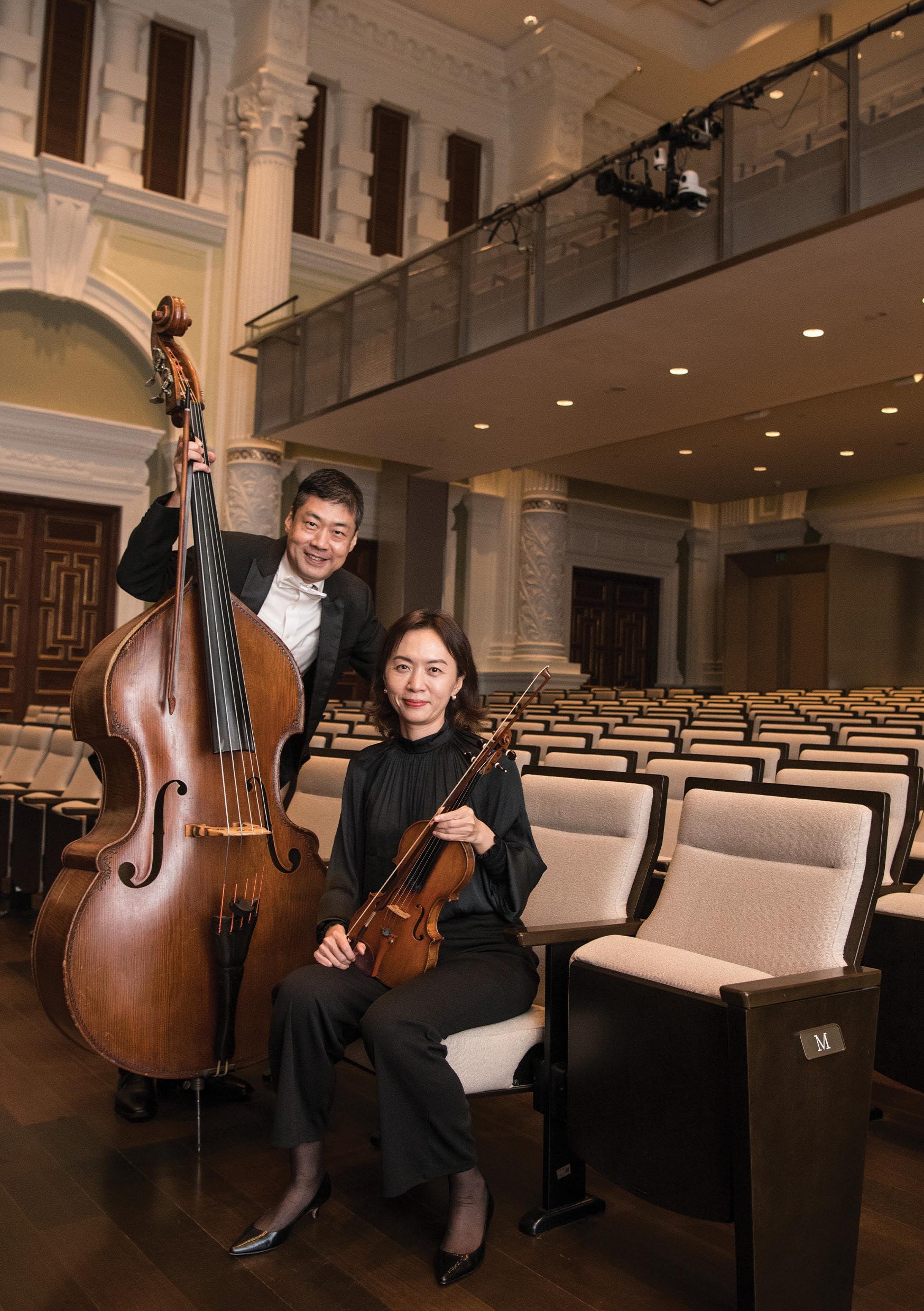


The vision of the Singapore Symphony Group is to be a leading arts organisation that engages, inspires and reflects Singapore through musical excellence. Our mission is to create memorable shared experiences with music. Through the SSO and its affiliated performing groups, we spread the love for music, nurture talent and enrich our diverse communities. The Singapore Symphony Orchestra is a charity and not-for-profit organisation. You can support us by donating at www.sso.org.sg/donate